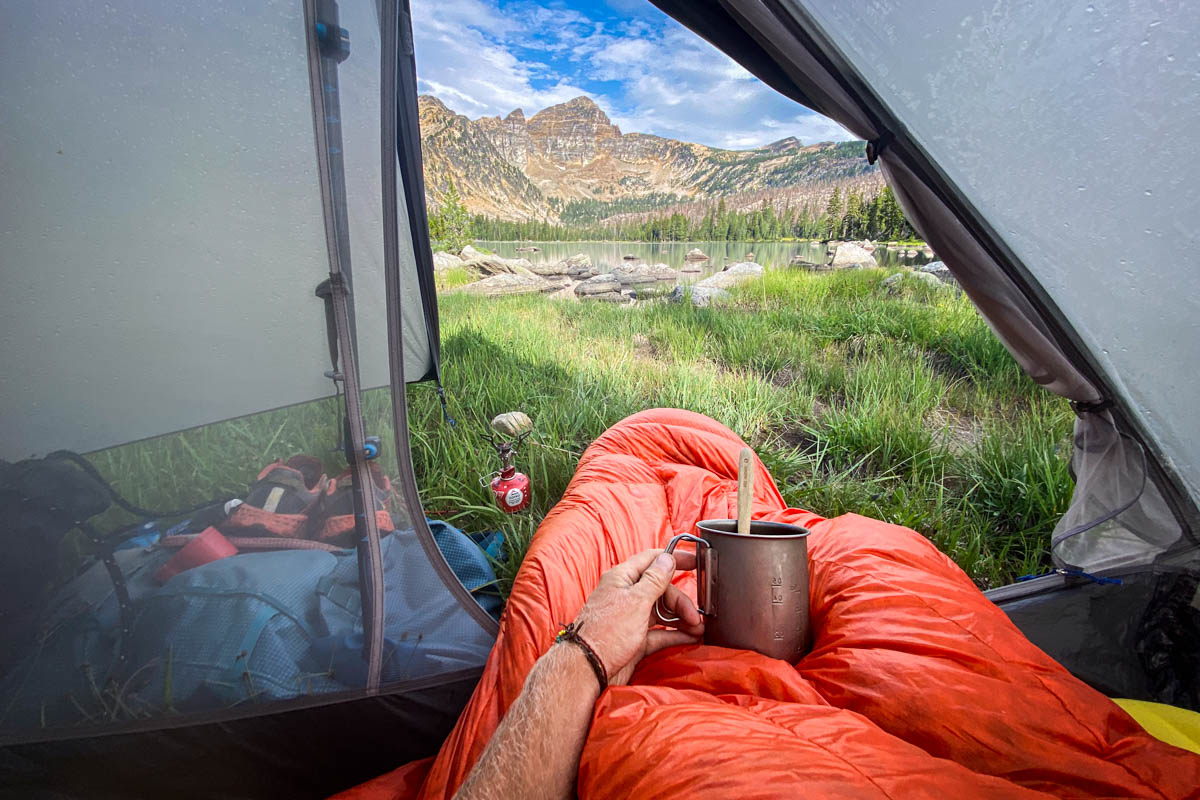
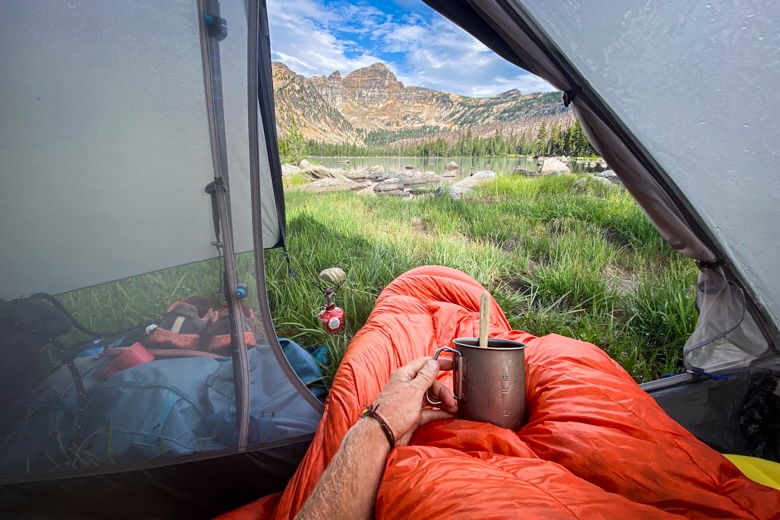
For all the minimalist backpackers, bikepackers, thru-hikers, and ounce-counters, the lightweight gear world is full of options to complete your sleep system. While many of the leading backpacking sleeping bags will get the job done, for those looking to truly pair down their base weight, an ultralight quilt or bag may be in order. We've been testing ultralight sleeping bags since 2016 and took countless models out on demanding tests all over the world to narrow in our robust selection of 25 standout quilts and bags below. We’ve broken our top picks for 2025 into two categories: ultralight sleeping bags, which include both traditional mummy bags and hoodless designs meant to be combined with a down puffy, and backpacking quilts that either attach to a sleeping pad or are used in a hammock. For more background information, see our comparison tables and buying advice below the picks, along with details about our testing process.
Editor's note: We updated this guide on May 5, 2025, to add the Nemo Pulse Endless Promise Quilt to our list. We also combed through the guide to ensure all other information—including prices, colorways, and designs—was current at the time of publishing.
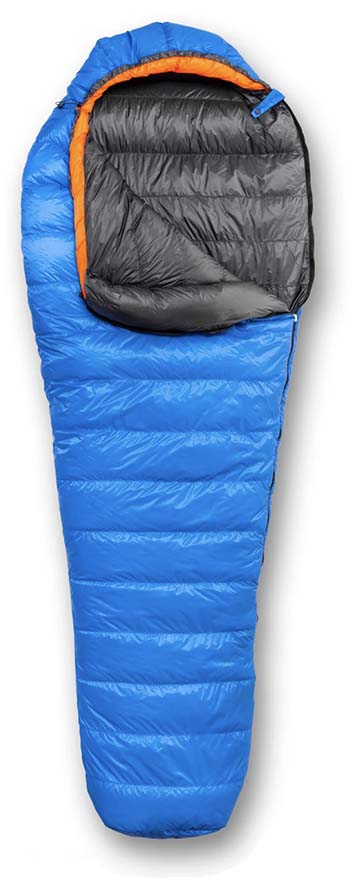 Temperature rating: 30°F
Temperature rating: 30°F
Other option: 20°F
Weight: 1 lb. 5.4 oz.
Fill: 11.5 oz. of 950-fill down
What we like: Extremely well built and warmer than the temperature rating suggests.
What we don’t: Heavier than most of the competition.
If you haven’t yet heard of Feathered Friends, we recommend that you get acquainted. This Seattle-based down specialist uses premium materials, has a diverse selection of products, and makes almost everything in the U.S. And because they only sell online and through their one retail location across the street from the REI flagship, we think you get more bang for the buck than the other ultralight elephant in the room: Western Mountaineering. Both make top-notch sleeping bags for serious outdoorspeople, but Feathered Friends is tough to beat.
For 3-season use, the Hummingbird UL is our favorite ultralight sleeping bag on the market. It’s stuffed with a generous 11.5 ounces of 950-fill goose down, has a thin but water-resistant 10-denier (D) Pertex Endurance shell, and is much warmer than other 30-degree bags (in our experience, Feathered Friends bags run warmer than their listed ratings). But the Hummingbird is overkill for summer use, and at 1 pound 5.4 ounces, it’s on the heavy side—true ultralight aficionados will want to save weight by sacrificing features like a hood, full-length zipper, and water-resistant shell. But the Feathered Friends nevertheless offers one of the best warmth-to-weight ratios here and comes with a great track record for quality and longevity.
See the Feathered Friends Hummingbird See the Women's Feathered Friends Egret
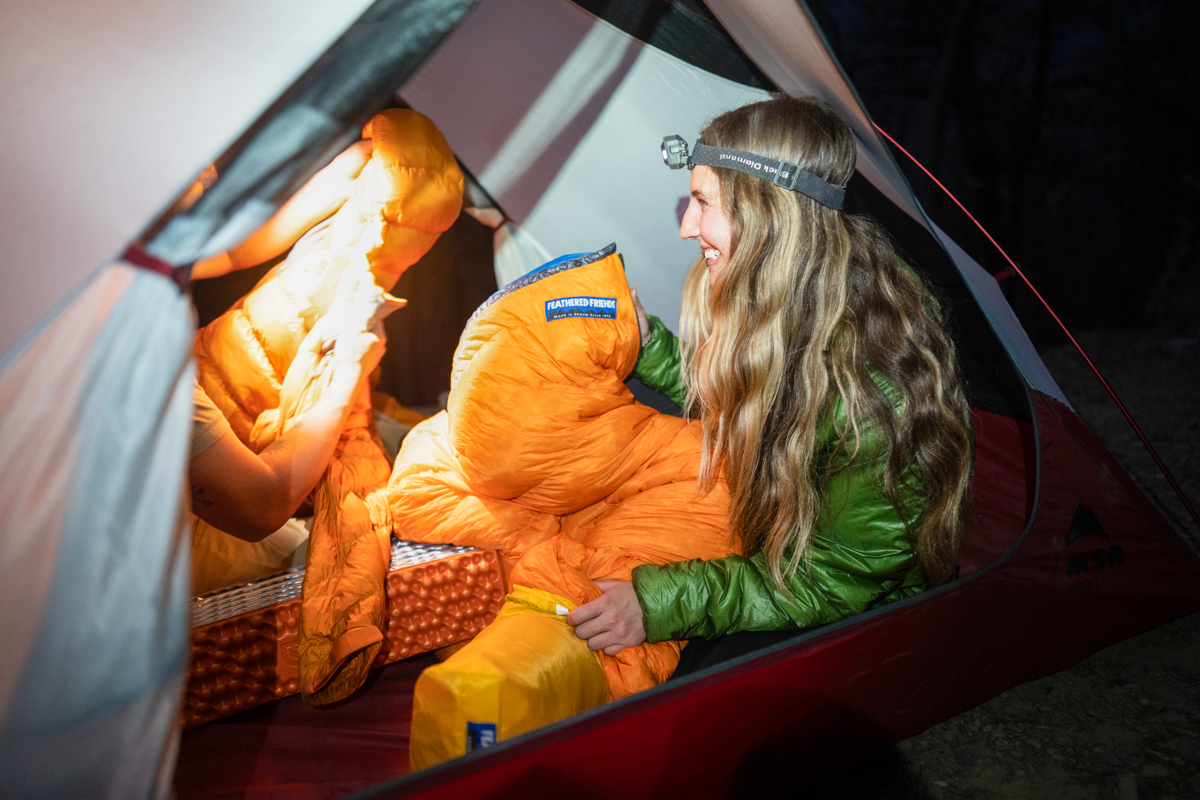
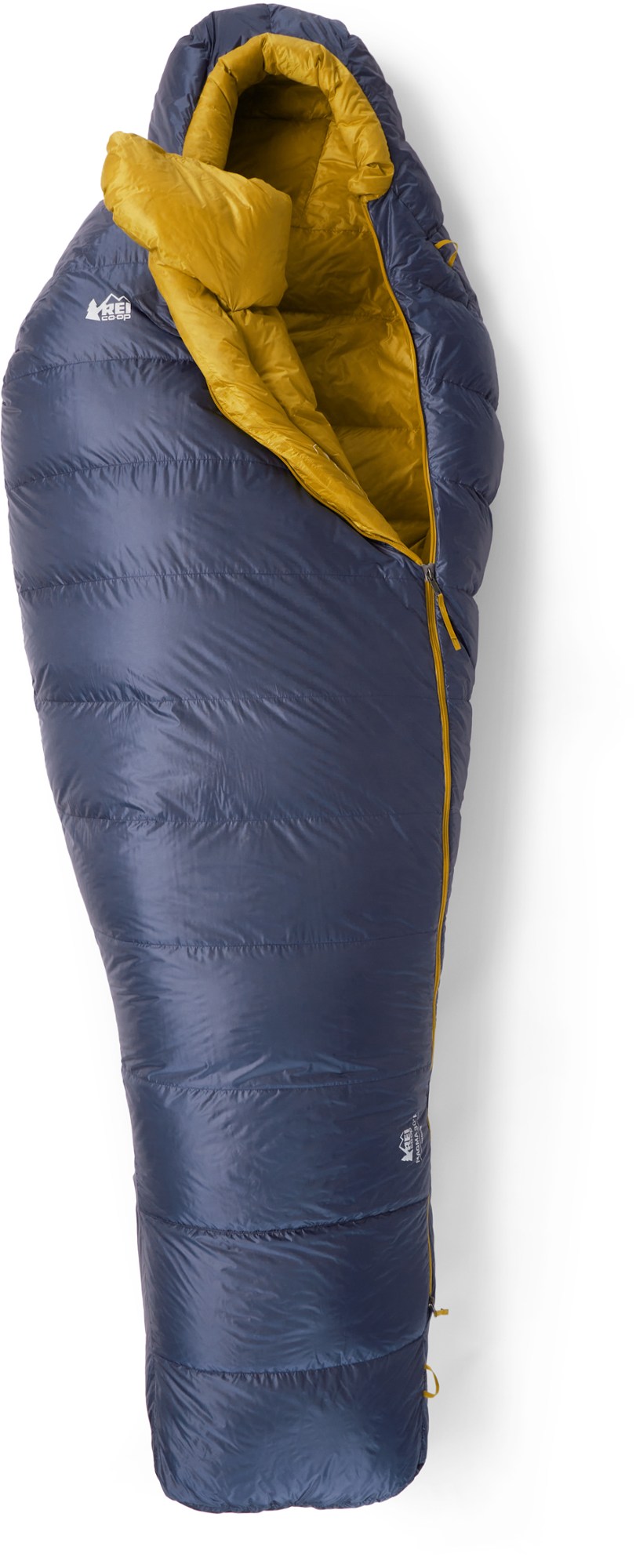 Temperature rating: 34°F ISO Comfort, 24°F Lower Limit
Temperature rating: 34°F ISO Comfort, 24°F Lower Limit
Other option: 15°F
Weight: 1 lb. 8.4 oz.
Fill: 12.7 oz. of 850-fill down
What we like: Light and inexpensive for what you get.
What we don’t: Lower-quality down than competing options from Feathered Friends (although it's not far off).
For the value seekers out there, REI Co-op’s hardgoods have seen a dramatic increase in quality in recent years, and the Magma sleeping bag is a case in point. For $379, you get a warm and well-built 30-degree bag that weighs just 1 pound 8.4 ounces (a slight weight bump from previous iterations). In addition, the shell is 15D Pertex, which is more durable than the Hummingbird (10D) above, and the shoulder and waist dimensions are more generous for a roomier night’s sleep (62.5/54 in. vs. 58/52 in. for a size medium). While it's not the cheapest option on this list, dollar for dollar, you’d be hard-pressed to find a better ultralight sleeping bag that still offers 3-season warmth at such a high fill weight.
The 12.7 ounces of 850-fill down competes with 30-degree offerings from Feathered Friends and Western Mountaineering—the Lower Limit of the Magma is rated at 24 degrees, while the Comfort rating is set to 34. Alternatively, if you run warm or only camp in fair weather, you can save a lot of money with a cheaper summer-weight bag. But the Magma’s boost in insulation is considerable, and with a full-length zipper, it’s versatile for a range of temperatures. Put simply, it'd be hard to find a bag that better balances warmth, weight, and price from such a trustworthy brand.
See the REI Co-op Magma 30
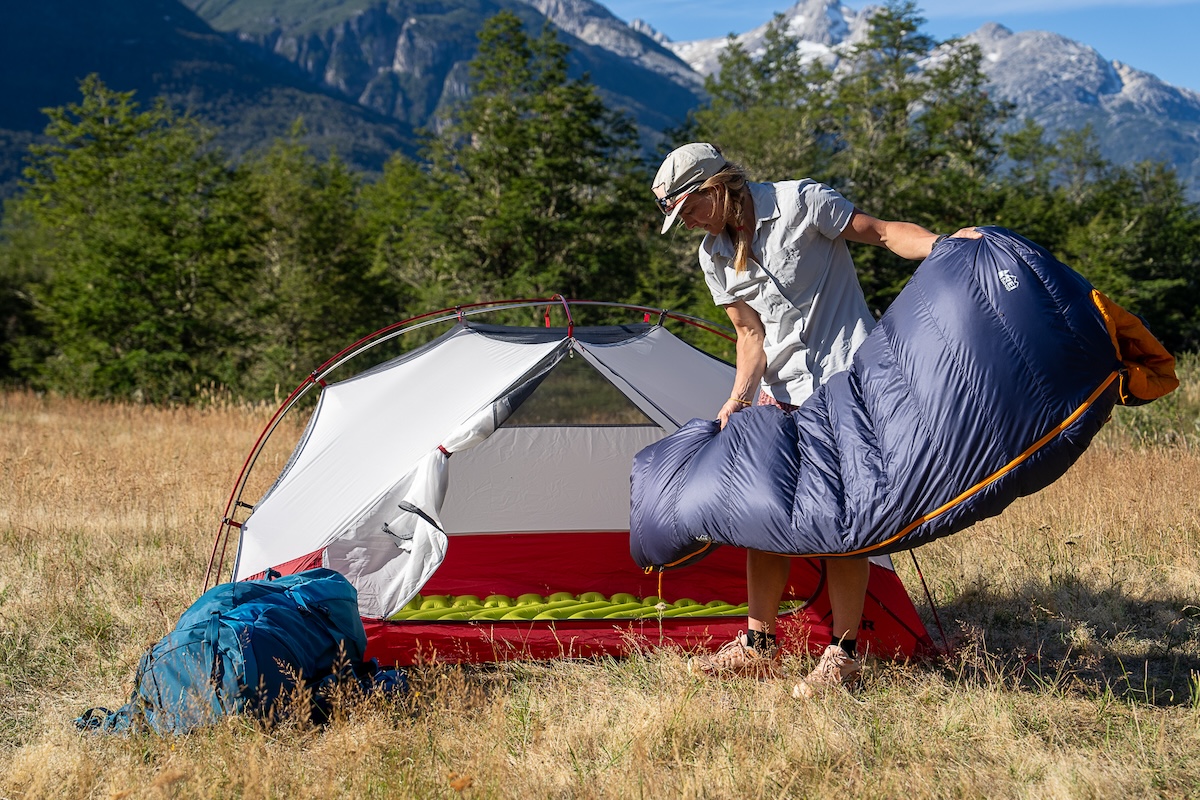
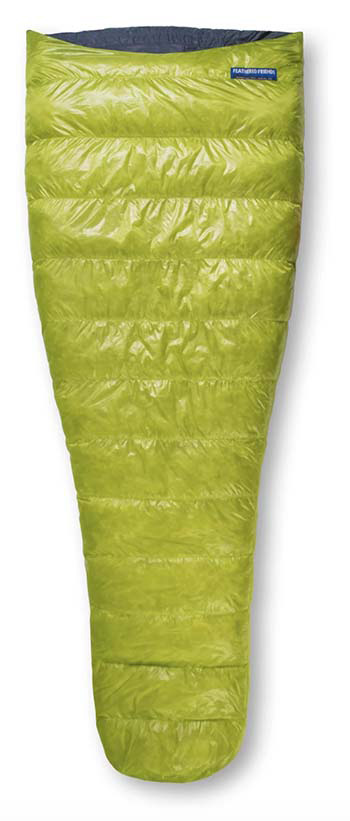 Temperature rating: 20°F
Temperature rating: 20°F
Weight: 1 lb. 2.6 oz.
Fill: 12.6 oz. of 950-fill down
What we like: Super comfortable and warm for its weight.
What we don’t: No zipper or hood; very thin materials.
A hoodless sleeping bag isn’t for everyone, but for diehard ULers who want to save weight without compromising warmth, it’s a really cool solution. Here’s the theory: You can keep your noggin warm with the hood of a down jacket or beanie (which you’re probably bringing anyway) and move that extra insulation to the rest of the bag, trapping your body’s heat with a drawstring at the neck. The net result is more insulation for less weight, which is worth the minor comfort sacrifice for most. The Feathered Friends Tanager is a shining example: Rated to 10 degrees colder than our top-ranked Hummingbird and checking in almost 3 ounces lighter, its warmth-to-weight ratio is truly impressive.
We must admit: We initially were skeptical, but the Tanager has kept us warm on many chilly mountain nights. That said, it’s important to keep in mind what you give up with such a limited feature set. With a zipperless design, getting in and out is a bit of a chore, and there’s no option for venting on warm nights. Additionally, the Tanager’s 7D by 5D outer fabric is noticeably thinner than most bags here and will require some extra care to avoid snags and tears. And on occasion (especially particularly cold nights), we have found ourselves wishing for the added coziness of a traditional, hooded design. But no gear is ultralight without some amount of compromise, and we think the Tanager pulls it off better than most. If you’ve been known to saw off the end of your toothbrush or use trekking poles to pitch your tent, this bag has your name on it.
Read more: Feathered Friends Tanager 20 review
See the Feathered Friends Tanager 20
.jpg)
 Temperature rating: 51°F ISO Comfort, 45°F Lower Limit
Temperature rating: 51°F ISO Comfort, 45°F Lower Limit
Other options: 0, 15, 30°F
Weight: 12.8 oz.
Fill: 5.3 oz. of 850-fill down
What we like: Crazy light and provides the wet-weather assurance of hydrophobic down.
What we don’t: Only recommended for mid-summer use.
If you think the options above are ultralight, you ain’t seen nothing yet. At just 12.8 ounces, the 45-degree Spark is the lightest fully featured sleeping bag on this list and comes complete with a hood and zipper. What’s more, it features hydrophobic down and packs smaller than a 1-liter Nalgene in the included compression sack. Sure, the Spark can’t compare with most of the picks here in terms of warmth—with a 45-degree Lower Limit rating, we only recommend it for balmy nights—but these specs are undeniably impressive, even for a summer-weight bag. The Spark's previous iteration had a short, 1/3-length zipper, which limited wiggle room and ventilation but kept weight and bulk low. This has now been improved a bit with a 1/2-length zip on the 45- and 30-degree options—adding a slight weight bump of 0.8 ounces—and a 3/4-length zip on the 15- and 0-degree models.
All that said, versatility is limited with such a lightweight design. To put it in perspective, the top-ranked Hummingbird contains twice the amount of down, which makes it more versatile for 3-season use. On top of that, its 10D shell isn’t the thinnest here (the Tanager’s above is 7D), but it will require considerable care when packing or sleeping outside on rough ground. But the Spark series is about as good as it gets if you’re looking to shave weight, and it’s worth checking out the 0, 15, and 30-degree versions for more warmth.
See the Men's Sea to Summit Spark 45 See the Women's Sea to Summit Spark 45
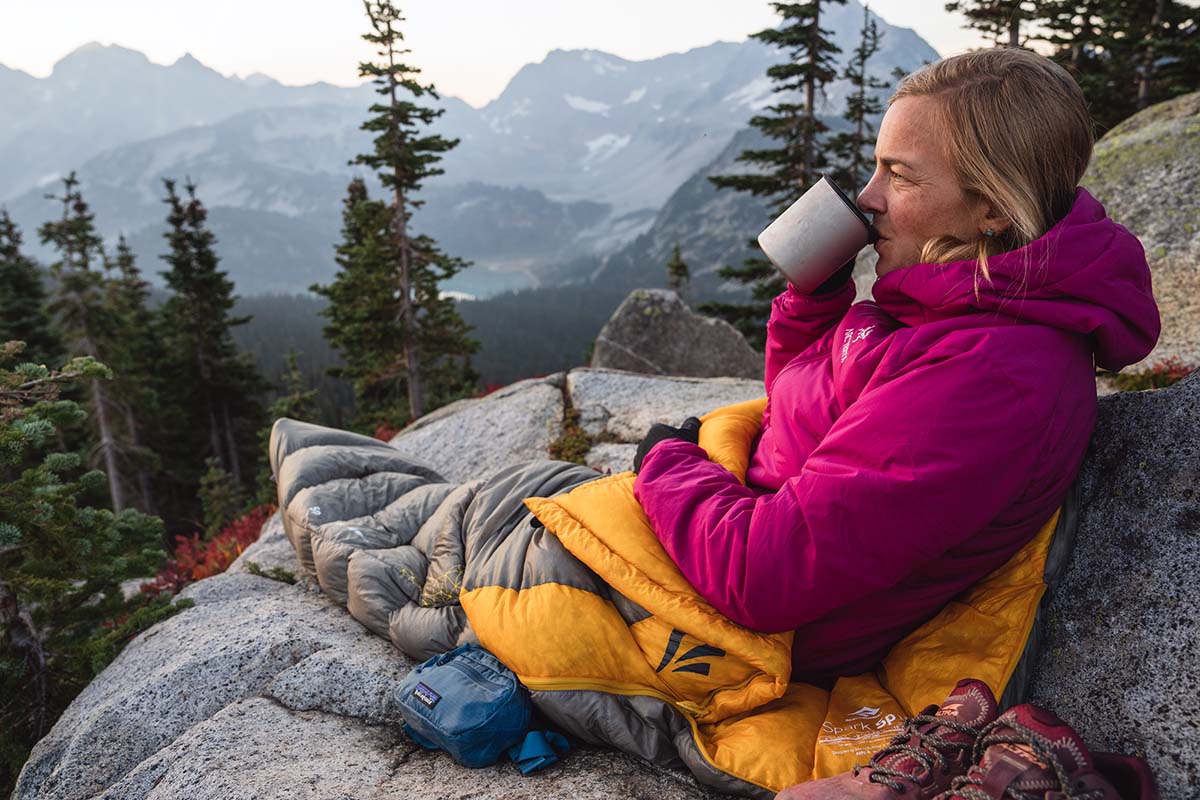
 Temperature rating: 35°F
Temperature rating: 35°F
Weight: 1 lb. 0 oz.
Fill: 8.0 oz. of 850-fill down
What we like: A fully featured mummy bag that weighs just 1 pound.
What we don’t: Limited warmth and half-length zipper isn’t great for dropping heat on warm nights.
There’s no denying that the Hummingbird UL above is a great ultralight pick, but at well over a pound, it’s just too heavy for some. While you won’t find a lighter fully featured bag within Feathered Friends’ lineup (the Tanager forgoes a zipper and hood), Western Mountaineering has a number of options to choose from. One of their most popular ultralight designs is the HighLite here, which checks in at a pound even and includes a half-length zipper and hood. The materials and construction are top-notch, with a strong shell fabric and a combination of sewn-through and baffled seams that balance weight savings and warmth. Sure, 8 ounces of down fill isn’t a lot, but it’s hard to argue with the efficiency of this Western Mountaineering design.
The HighLite’s 35-degree temperature rating is only 5 degrees shy of the Hummingbird’s, but a quick look at the specs tells us there’s more to the story. While you get a generous 11.5 ounces of 950-fill down with the Feathered Friends, the Western Mountaineering packs in only 8 ounces, and it's a lower fill-power down to boot. Further, the half-length zipper compromises ventilation and versatility. These gripes aside, you’d be hard-pressed to find this much warmth packed into a 1-pound mummy bag, and the HighLite should be fully sufficient for most summer nights (even in the mountains). If you want to go even lighter with WM, check out their FlyLite (36°F; 14.3 oz.) or hoodless Monolite (38°F; 13.8 oz.).
See the Western Mountaineering HighLite
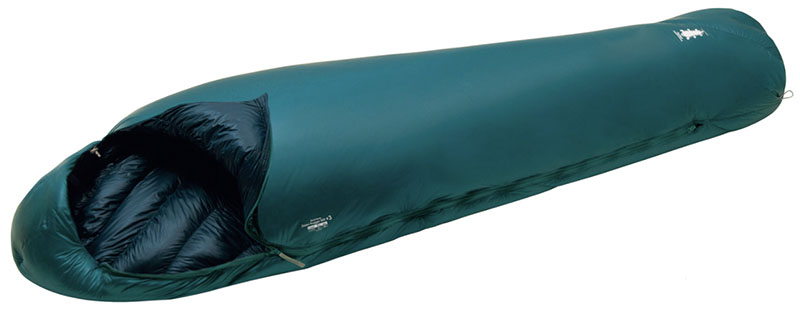 Temperature rating: 39°F ISO Comfort, 30°F Lower Limit
Temperature rating: 39°F ISO Comfort, 30°F Lower Limit
Other options: 15, 25, 40°F
Weight: 1 lb. 2.7 oz.
Fill: 800-fill down
What we like: Baffle-free exterior and internal diagonal baffles nicely balance weight and comfort.
What we don’t: Shell is thin and fragile.
Montbell’s Seamless Down Hugger is truly a work of art. Instead of standard baffles, it uses a web of polyester threads (dubbed the “Spider Baffle System”) to keep the down insulation in place. As a result, it achieves more warmth with less insulation (read: less weight) compared with Montbell’s standard sleeping bag designs. And on the inside, the liner features a spiraled elastic thread that expands with your movements and constricts to hug your body, effectively trapping warmth. Added up, the Seamless Down Hugger is an incredibly effective sleeping bag that's great for a range of body sizes and will make side sleepers happy, too.
In terms of features, the Down Hugger is premium through and through. The 10D shell—while undeniably thin—is made with Montbell’s Ballistic Airtight nylon, which is tightly woven to increase tear resistance. Further, the zipper is two-way, which means you have the option of venting at the shoulders or the lower legs. And at 1 pound 2.7 ounces, it gives other models on this list a run for their money in terms of warmth for the weight. Finally, it’s worth noting that Montbell offers the Seamless Down Hugger in a variety of fill weights (900, 800, and 650-fill) and temperature ratings (15, 25, 30, 40°F), including “WR” models with windproof Gore-Tex Infinium shell fabrics and water-resistant zippers for added assurance in inclement weather.
See the Montbell Seamless Down Hugger 800 #3 See the Women's Montbell Down Hugger 800 #3
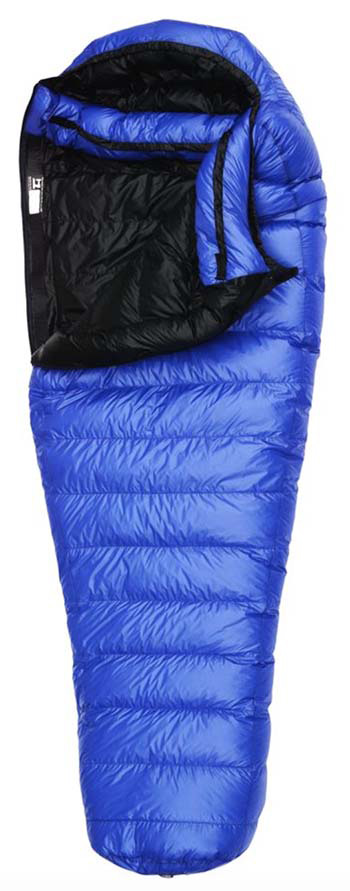 Temperature rating: 20°F
Temperature rating: 20°F
Weight: 1 lb. 13.0 oz.
Fill: 16.0 oz. of 850-fill down
What we like: Warmer than the SummerLite and HighLite.
What we don’t: 5 ounces heavier than the 20-degree Feathered Friends Hummingbird above.
A good number of the sleeping bags on this list are designed for summer adventuring, but the Western Mountaineering UltraLite is a serious step up. With 16 ounces of 850-fill down and a 20-degree temperature rating, it’s much more alpine-centric than the HighLite above and SummerLite below. You also get a plush draft collar and hood, continuous baffles, and a respectable weight of less than 2 pounds. This bag may be overkill for warm weather and low elevations, but it provides more security for mountain environments and shoulder seasons when temperatures can really drop.
The biggest competitor to the Western Mountaineering UltraLite is the 20-degree version of the Feathered Friends Hummingbird UL listed above. Interestingly, the UltraLite has a higher fill weight (16 vs. 14 oz.), although the Hummingbird uses ultra-lofty 950-fill-power down that offsets some of that difference. On the flip side, the Western Mountaineering is a notable 5 ounces heavier, which is what made the difference for us. Both are excellent ultralight 20-degree bags and your final choice might come down to availability, but we give a slight nod to the Feathered Friends. And if you want a bit more room, check out Western Mountaineering’s AlpinLite, which adds 5 inches at the shoulders and 4 inches at the hips.
See the Western Mountaineering UltraLite
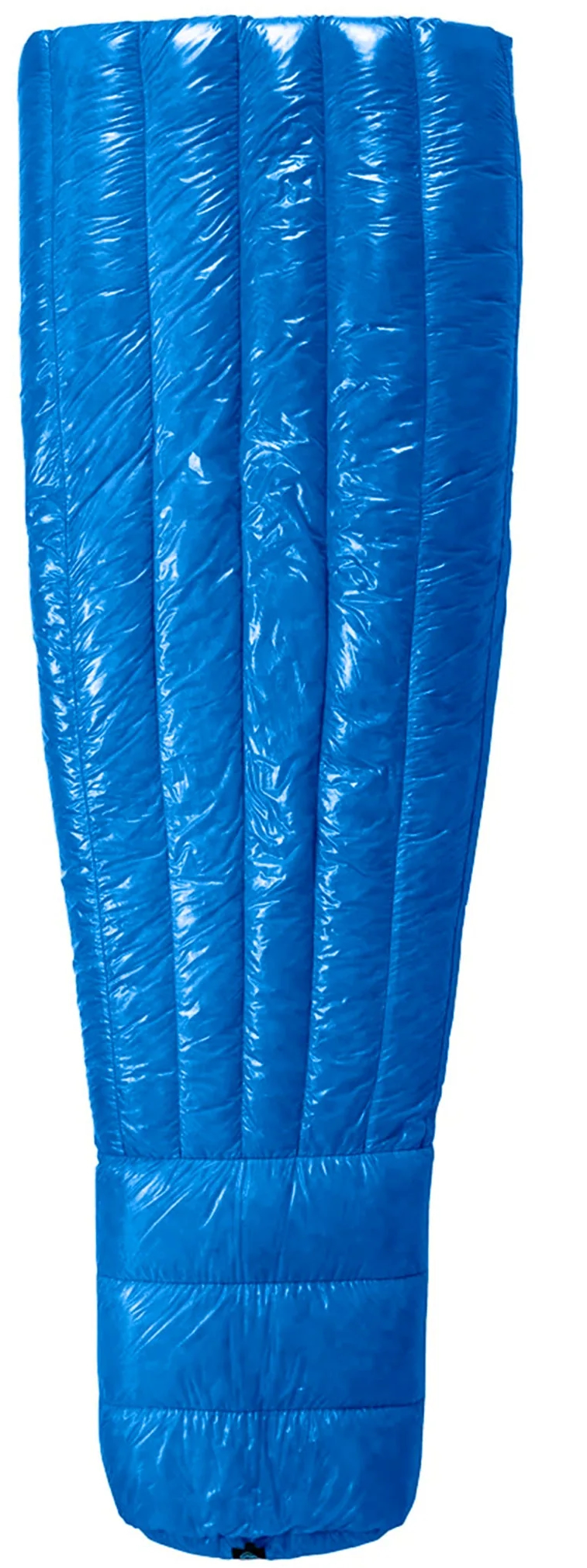 Temperature rating: 20°F
Temperature rating: 20°F
Other options: 10, 30°F
Weight: 1 lb. 2.8 oz.
Fill: 13.7 oz. of 900-fill down
What we like: Great warmth-to-weight for a decent price; versatile design doubles as a quilt.
What we don’t: Feels less refined than other brands.
Zpacks is one of the biggest names in ultralight gear, widely known for their Dyneema tents and backpacks. The cottage brand also makes a wide assortment of down sleeping bags and quilts, which—true to ultralight form—offer a high degree of customization in terms of temperature rating, length, width, and color. One of their three sleeping bag options, the hoodless Classic features a 3/4-length zipper along the back, which is a versatile design that allows you to drape it over you like a quilt or zip it up like a standard sleeping bag. And because the zipper will likely be under you as you sleep, the need for a draft tube is eliminated, thus saving on weight.
The 20F Classic here features 13.7 ounces of RDS-certified 900-fill down, which puts it in the realm of bags like the Feathered Friends Tanager above. We like the vertical baffles, which keep down from migrating to the side of the bag, and the 2.5 inches of loft offers an incredibly plush and cozy feel. And at $459 (20-degree, standard, medium), the Classic is competitive in terms of price, too. But you have to watch out with Zpacks: Their products do have a slight handmade feel, including occasional loose threads and uneven seams. That said, if you care about warmth-to-weight ratios above all else, the Classic is certainly worth a closer look—and while you’re at it, check out the Zpacks’ Zip Around and Mummy Sleeping Bag, too.
See the Zpacks 20F Classic
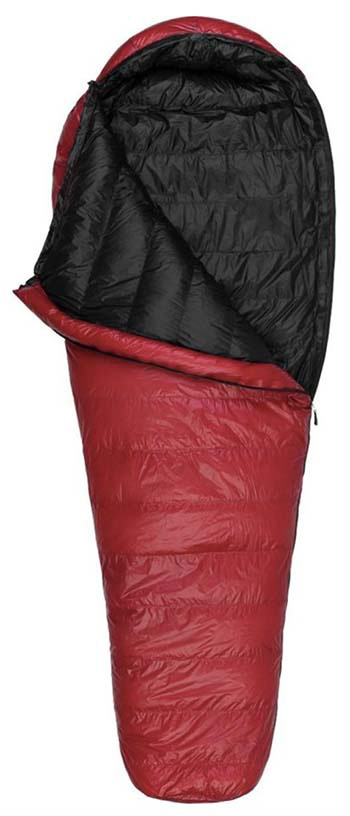 Temperature rating: 32°F
Temperature rating: 32°F
Weight: 1 lb. 3.0 oz.
Fill: 9.0 oz. of 850-fill down
What we like: More features than the HighLite above and lighter than the UltraLite.
What we don’t: The Hummingbird UL offers better warmth for the weight.
Slotting right in between the HighLite and UltraLite, the Western Mountaineering SummerLite is a well-balanced bag for summer backpackers. You get an ounce more 850-fill down than the HighLite, dropping the temperature rating down to 32 degrees Fahrenheit, in addition to a full-length #5 YKK zipper. These distinctions might not seem like a lot, but for us, they’re the difference between a minimalist UL bag and a functional daily driver. On the other end of the spectrum, the SummerLite is 10 full ounces lighter than the UltraLite, which is substantial enough to matter. For an uncompromised summer bag that can eke out a night or two in the shoulder seasons, we really like the SummerLite.
If you’re willing to drop the big bucks for a Western Mountaineering or Feathered Friends bag, it’s not a question of which is the best model (they’re all good) but more about discerning which is best for you personally. We understand the appeal of more insulation, but in reality, a 32-degree bag will get the job done for most thru-hikers and fastpackers, and you won’t be sweating the night away like you might in a warmer model. Looking at it a different way, the Hummingbird UL above is just 2.4 ounces heavier but contains 2.5 ounces more down (of a higher fill power), making it the clear winner in terms of warmth for weight. It’s hard to go wrong with any of the bags mentioned here, but if you’re going to spend $500 (or more), you’ll want to have a good idea of your end use.
See the Western Mountaineering SummerLite
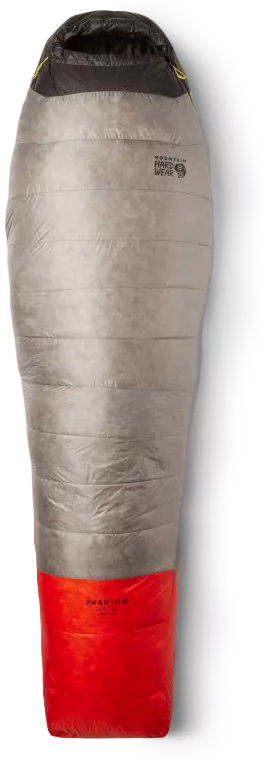 Temperature rating: 30°F
Temperature rating: 30°F
Other options: 0, 15°F
Weight: 1 lb. 6.1 oz.
Fill: 10.1 oz. of 800-fill down
What we like: Well-designed zipper and competitive price.
What we don’t: Lacks the warmth-to-weight of premium bags from Feathered Friends and Therm-a-Rest.
Mountain Hardwear is yet another brand with a great selection of thoughtfully designed sleeping bags, and the Phantom 30F is their ultralight offering. The Phantom goes head to head with a bag like the Western Mountaineering SummerLite above, combining similar amounts of insulation with a functional feature set. Mountain Hardwear shaves weight with a streamlined shape and thin, 10D shell fabric (the same material used in their popular ultralight Ghost Whisperer jacket), but they don’t skimp on the zipper, which is almost full-length, reasonably robust, and uses an anti-snag head. We’ve been disappointed by fragile and snag-prone zippers from Mountain Hardwear in the past, so the current Phantom’s design is a welcome improvement.
The Phantom is a suitable bag for most summer conditions, but its warmth falls short of top performers from brands like Feathered Friends and Therm-a-Rest. The 30-degree model uses 10.1 ounces of 800-fill down (a slight downgrade from the previous model's 850-fill power), which simply can’t match bags like the Tanager (12.6 oz. of 950-fill), which checks in at a lighter weight but forgoes a full-length zipper. But compared to less compromised bags like the Hummingbird and SummerLite, the Phantom’s warmth-to-weight is a bit more competitive, and it'll cost you less than the Hummingbird, too. We’re partial to down specialists like Feathered Friends and Western Mountaineering—the level of quality is hard to beat—but the Phantom is nevertheless a great summer-weight sleeping bag for those looking to streamline weight and bulk.
See the Mountain Hardwear Phantom 30F
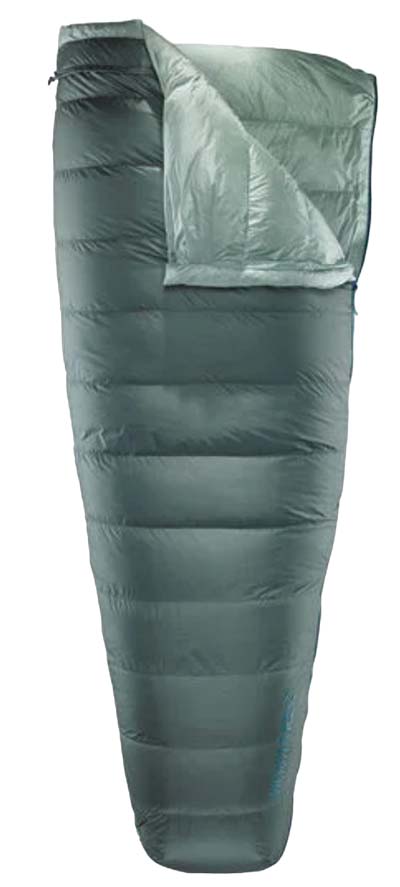 Temperature rating: 32°F Comfort, 20°F Lower Limit
Temperature rating: 32°F Comfort, 20°F Lower Limit
Weight: 1 lb. 6.0 oz.
Fill: 12.5 oz. of 900-fill down
What we like: A lot of versatility and warmth at a low weight.
What we don’t: Not everyone will need the wraparound zipper.
Those in search of a roomier and more versatile bag than lighter options here should consider the Ohm. With premium 900-fill hydrophobic down, it’s light and packable for its weight, but the comfort-first design is what’s truly impressive. The hoodless Ohm features a semi-rectangular shape that makes it less restrictive than many ultralight mummy bags, and the full-length zip extends through the toe box, allowing you to zip the bag open into a blanket. For use in a variety of 3-season conditions or those who run warm, the Ohm is a temperature-regulating champ.
With the added weight of a full-length zipper, the Ohm certainly isn’t the lightest option in its class. Feathered Friends' Tanager 20, for example, is about 3.5 ounces lighter and uses even loftier (read: warmer) down fill. But that bag can't compete with the Ohm in terms of versatility, especially for larger frames, varying conditions, or warm sleepers. And couples, take note: You can zip two Ohms together for a comfortable but still lightweight two-person sleep system.
See the Therm-a-Rest Ohm 20F
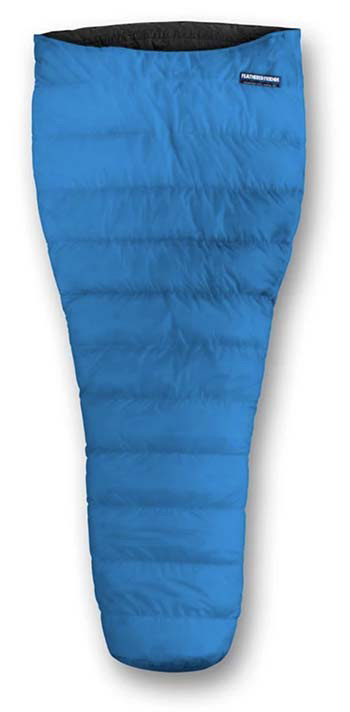 Temperature rating: 25°/45°F
Temperature rating: 25°/45°F
Weight: 15.5 oz.
Fill: 8.7 oz. of 950-fill down
What we like: Unique insulation patterning eliminates a ton of weight.
What we don’t: The warmer Tanager weighs only 3 ounces more.
We’ll wrap up our sleeping bag picks with a unique offering from Feathered Friends: the alpine-specific Vireo UL. Like the Tanager above, the Vireo is a hoodless, zipperless bag designed to be worn with a warm down jacket. But Feathered Friends took it to the next level in the name of weight savings, concentrating most of the down on the lower half of the bag (this means that you must bring a down puffy, and potentially a warm one at that). In the end, the Vireo is 3.1 ounces lighter than the Tanager but potentially almost as warm—you get insulation down to 25 degrees for the lower body and 45 degrees on top.
If you’re going to spend the night out in sub-freezing temperatures but don’t want the weight and bulk of a bag like the UltraLite, the Vireo is an intriguing choice. That said, for less than an ounce more, you could have more full-body coverage (including a hood) with a bag like the popular Therm-a-Rest Hyperion (1 lb. even for the regular size). And for warmer temperatures, we’d point you toward a more versatile and lighter option like the Sea to Summit Spark above. All in all, the Vireo is an extremely niche piece, but it is also beloved by alpine climbers as a great sub-1-pound alternative to the shiver bivy.
See the Feathered Friends Vireo UL
 Temperature rating: 20°F
Temperature rating: 20°F
Other options: 0, 10, 30, 40, 50°F
Weight: 1 lb. 5.2 oz.
Fill: 15.5 oz. of 850-fill down
What we like: Reasonably priced, super customizable, and a generous amount of down.
What we don’t: Long wait time for customs and some might not like the enclosed footbox.
Backpacking quilts are the bread and butter of Minnesota-based Enlightened Equipment (EE), so it’s no surprise to see their Enigma at the top of our list for 2025. This quilt packs a serious punch with a whopping 15.5 ounces of down—that’s more than all but one of the sleeping bags listed above—and it’s all concentrated along the front and side the body. Further, EE quilts are handmade, can be customized into a variety of sizes (16 combinations of length and circumference), and you have the option of 850- or 950-fill down, along with a whole range of temperature ratings. Priced at a reasonable $355 (regular length, regular width, 850-fill) the Enigma is our top choice for quilt fans and skeptics alike.
Speaking of skeptics: We were squarely in that camp before testing the Enigma but now are bona fide believers. In fact, we haven’t had a cold night in the 20-degree quilt despite taking it to Patagonia, deep into the North Cascades, and up to 13,000 feet in the Sierra. One of our editors has also completed both the CDT and the AT sleeping in the same Enigma. It kept him safe and warm during snow-blasted nights in the San Juans and weeks of endless drizzle in the White Mountains. We regularly opt for the Enigma over our ultralight sleeping bags above, as it’s far less constricting and vents better on warm nights. It's good to know that EE also makes the popular Revelation (which features the option for an open footbox), the zippered Convert, and the aptly named two-person Accomplice (below). Of note: Most Enlightened Equipment products are made to order, which is great for customization but not ideal for wait time. If you're not particular about colors, you can choose an in-stock version that will ship within three business days.
Read more: Enlightened Equipment Enigma 20 review
See the Enlightened Equipment Enigma
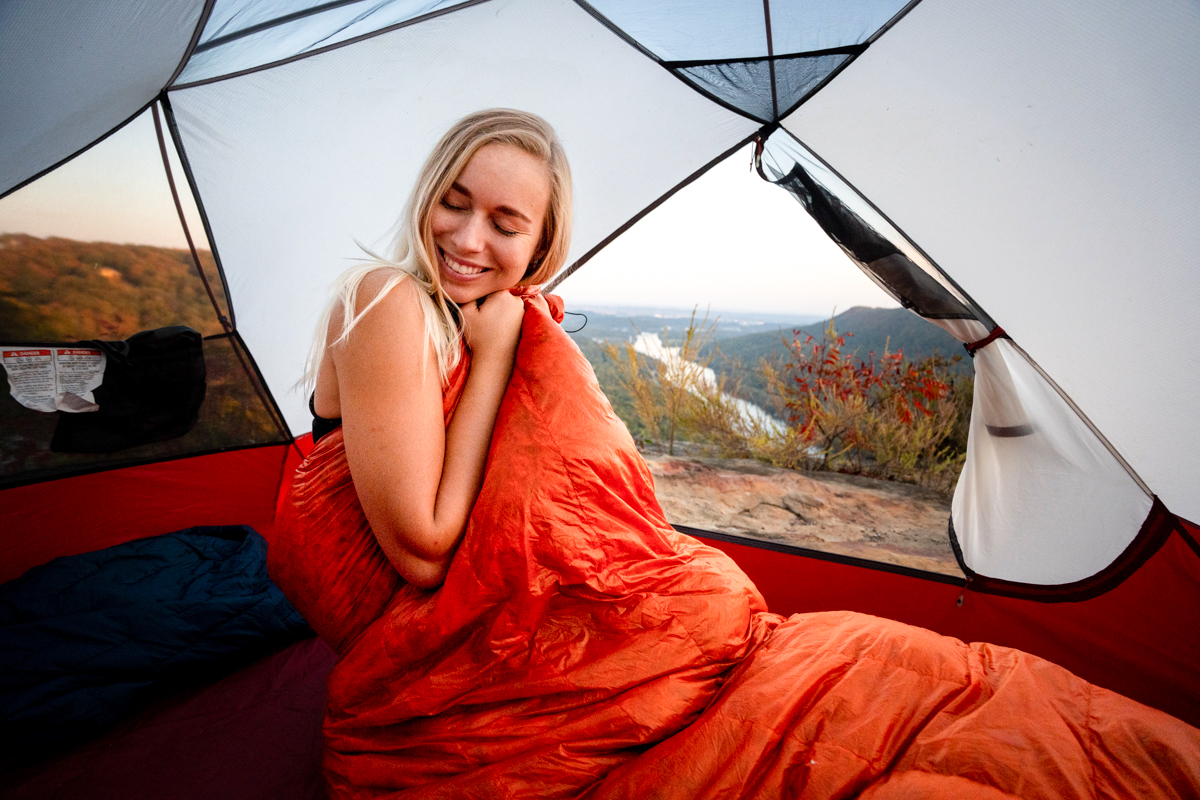
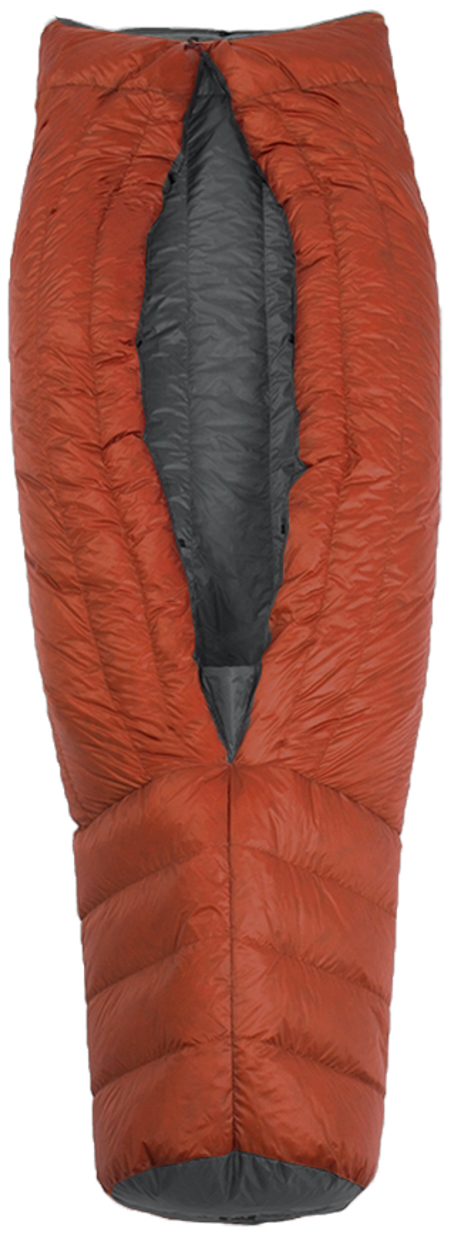 Temperature rating: 30°F
Temperature rating: 30°F
Other options: 0, 10, 20, 40°F
Weight: 1 lb. 4.7 oz.
Fill: 11.6 oz. of 850-fill down
What we like: A high-quality down quilt at a very low price.
What we don’t: A bit heavier than most other 30-degree quilts here.
You can easily spend $500 on a backpacking quilt, but Hammock Gear’s Burrow is a high-quality design for a budget-friendly $305 (standard length and width, zipper footbox, 850 fill, 10D fabric). The specs are truly impressive for the price, with a generous amount of down and a 1-pound-4.7-ounce build that stacks up fairly competitively to most other options. And like many cottage brands, Hammock Gear offers an array of customizations, allowing you to choose temperature rating, length, width, footbox design (zippered or sewn), fabric weight (10 or 20D), colors, and even extra down fill.
Hammock Gear’s offerings were originally designed for use in hammocks, so you’ll want to upgrade your quilt for sleeping on the ground. Luckily, the cost of customization is very low: Hammock Gear offers a ground pad attachment kit for $5, and most will opt for the standard 55-inch width. The key downside is that the Burrow isn’t all too competitive in terms of weight, although you can make a few tweaks to the shell fabric and down fill to bring it closer to the efficiency of a quilt like the Enigma above. And if you’re willing to spend up, Hammock Gear also offers the Burrow UL, which is significantly pricier (a starting price of $355 for the 30°F model) but shaves weight with a higher-quality 950-fill-power down and thinner (7D) shell fabric.
See the Hammock Gear Burrow
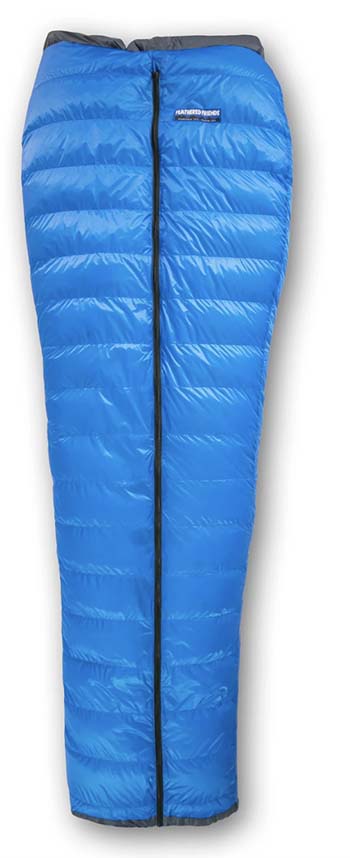 Temperature rating: 30°F
Temperature rating: 30°F
Other options: 20, 40°F
Weight: 1 lb. 6.0 oz.
Fill: 11.6 oz. of 950-fill down
What we like: The versatility of a quilt with the wraparound security of a sleeping bag.
What we don’t: Heavy compared to other quilts.
If we had one word to describe the Flicker UL from Feathered Friends, it would be “versatile.” On one hand, the Flicker has nearly identical specs as the Hummingbird UL sleeping bag above, with 11.6 ounces of 950-fill down (the Hummingbird has 11.5 oz.), very similar weights, and a full-length zipper. On the other hand, with no hood and a cinchable footbox, it can be opened up like a quilt in warm weather, and the wide version is great for plus-sized backpackers or two sleepers. It’s tough to categorize the Flicker UL, but at the end of the day, it’s both quilt and sleeping bag, which is quite an impressive feat.
The biggest point of differentiation between the Flicker UL and other quilts on this list is the full-length zipper. While some might complain that a zipper adds weight, others will appreciate the versatility. For example, the Enlightened Equipment Enigma above may offer a superior warmth-to-weight ratio, but that’s if you get it just right—any movement in the night can expose your body to cold drafts. On the other hand, 1 pound 6 ounces is heavy for most quilt fans. In the end, we recommend the Flicker as a nice all-in-one option for those on the fence between a sleeping bag and a quilt.
See the Feathered Friends Flicker UL
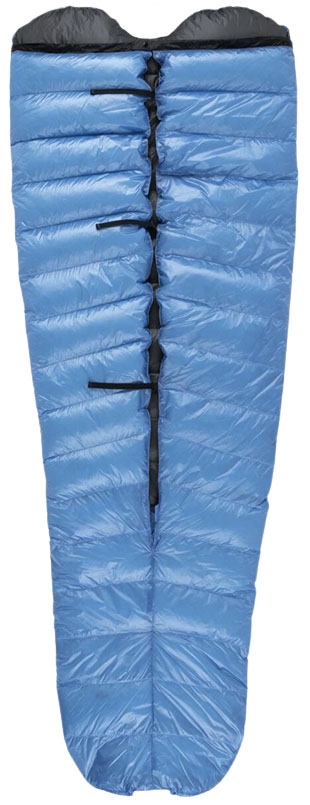 Temperature rating: 38°F
Temperature rating: 38°F
Weight: 13.3 oz.
Fill: 6.5 oz. of 850-fill down
What we like: Extremely lightweight for warm temperatures and low elevations.
What we don’t: Pricey and low on down fill—this truly is a summer quilt.
Western Mountaineering has made some of the best ultralight sleeping bags on the market for decades, so we were very excited when they introduced quilts to their lineup. The first thing you’ll notice about the NanoLite is the weight: At 13.3 ounces, it’s the lightest quilt on our list—and also one of the least insulated. But we love the concept of a quilt for warm weather: Unlike lightweight sleeping bags with the 1/3-length zip, the NanoLite allows much more versatility. Drape it across your body on warm nights or cinch the back all the way up when the mercury drops. Notably, the NanoLite also has a generous shoulder girth of 68 inches, allowing it to wrap all the way around your body, along with an insulated collar.
It's important to keep in mind, however, that the NanoLite’s use is definitively limited to summer nights and lower elevations. It has approximately half the down fill of the 30-degree Enlightened Equipment Enigma above, which certainly gives us pause. In addition, $420 is fairly steep for such a limited temperature range, especially considering that the same amount of money could get you a fully featured mummy bag like the Sea to Summit Spark 45 above. But for thru-hiking the Appalachian Trail or bikepacking near sea level, the NanoLite’s combination of weight and versatility is second to none. And keep in mind that Western Mountaineering also offers a warmer option in their AstraLite Quilt (26°F), which checks in at 1 pound and features 10.5 ounces of 850-fill down.
See the Western Mountaineering NanoLite
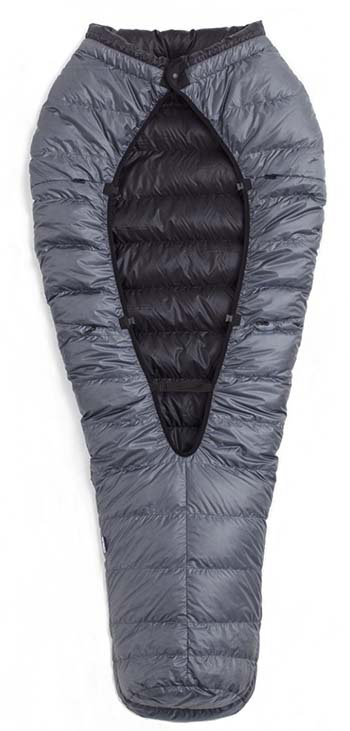 Temperature rating: 30°F
Temperature rating: 30°F
Other options: 15, 22°F
Weight: 1 lb. 3.8 oz.
Fill: 12.0 oz. of 850-fill down
What we like: Premium design; pad attachment goes a long way in eliminating drafts.
What we don’t: Less down yet more expensive than the Enigma.
Katabatic’s 30-degree Palisade Quilt has garnered a lot of attention, and for good reason. Most noteworthy is its unique back closure: Two thin, 2-millimeter cords secure the quilt to your sleeping pad, and a sliding toggle system locks it in place close to your body. In practice, this does an excellent job keeping out drafts, whether you’re on your back, your side, or moving between the two. And if you choose to go sans sleeping pad, a series of three straps cinch the bag shut in the back. With three lengths to choose from and the option between regular and wide versions (54 and 58-in. shoulder widths), the Palisade is a versatile and highly adaptable option (the $349 price point is for the 5'6", 850-fill model).
Compared to the 30-degree version of the Enigma above, the Palisade has a bit less down (12 oz. vs. 12.4 oz. of 850-fill) and is almost 2 ounces heavier. The Enlightened Equipment also gets the edge with its vertical baffles (better for keeping down from drifting to the sides) and slightly lower price point (the 30°F Enigma starts at $320). But there’s no denying Katabatic’s premium build quality, and—similar to the Enigma—you can further customize the Palisade in terms of sizing and down fill (including hydrophobic varieties). It’s also worth looking at Katabatic’s Alsek (22°F) and Sawatch (15°F) quilts, as well as the blanket-style Flex (available in 5, 15, 22, 30, and 40°F options).
See the Katabatic Gear Palisade 30
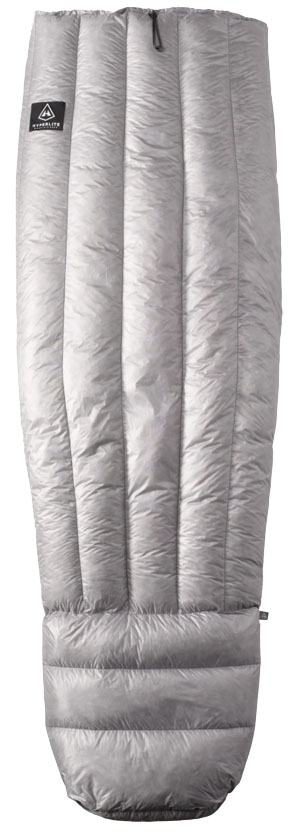 Temperature rating: 20°F
Temperature rating: 20°F
Other option: 40°F
Weight: 1 lb. 4.1 oz.
Fill: 1,000-fill down
What we like: Premium in every way.
What we don’t: More expensive than most quilts here.
Hyperlite doesn’t do anything halfway, so their foray into sleeping quilts got our full attention. True to form, the 20-Degree Quilt holds nothing back, with top-of-the-line 1,000-fill-power goose down and a thin 7D micro-ripstop nylon shell with a DWR finish. In true Hyperlite style, the quilt has a high-end feel and classy silver colorway, and every detail exudes quality, from the 3D baffles and sleek neck drawcord to the thick logo patches. And it’s customizable for ground and hammock sleepers alike: You can snug the quilt around your body with three integrated clips or use the streamlined attachment straps to secure it to your sleeping pad.
The Hyperlite’s 1,000-fill-power down is the loftiest here (shared with Nemo's Pulse below), and it measures up in practice: This quilt offers the closest experience we’ve had to sinking into a pillowy cloud. And for the amount of warmth and coziness it offers, it’s also impressively lightweight, checking in over an ounce lighter than the Enlightened Equipment above. The most obvious pitfall is price: $499 is a lot to spend on a quilt, especially considering you can save about $150 with a high-quality option like the Enigma. But if you’re looking for the best quilt money can buy, the Hyperlite can't be missed. It’s also worth noting Hyperlite offers a 14.4-ounce 40-Degree Quilt ($399), which is a great option for summertime use.
Read more: Hyperlite 20-Degree Quilt review
See the Hyperlite Mountain Gear 20-Degree Quilt
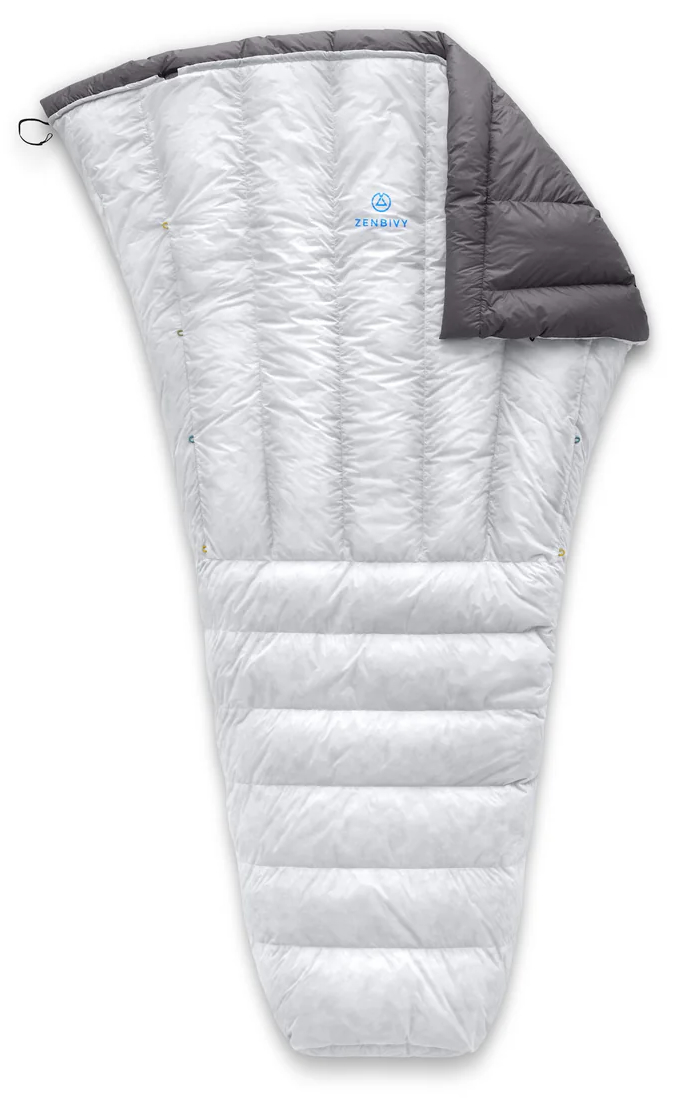 Temperature rating: 25°F
Temperature rating: 25°F
Other option: 10°F
Weight: 1 lb. 3.7 oz. (Quilt + Sheet)
Fill: 900-fill down
What we like: Great for side sleepers and those who don't do well in traditional mummy bags.
What we don’t: Expensive; the more involved setup can be awkward in a small tent.
When the internet is stippled with reviews like "the best sleep I've had in the backcountry," "you won't know you left the comfort of your home," and so on, we were skeptical. However, when our own editor-in-chief said the same after a long backpacking trip through the rugged Wind River Range, we knew Zenbivy was up to something special. Their Ultralight Quilt + Sheet (the "Ultralight Bed") combines the simple lightweight silhouette of a traditional quilt with the functionality of a 2.7-ounce draft sheet (either insulated or not). While quilts make it very tricky to eliminate drafts, the sheet straps to your sleeping pad and clips to the quilt, providing a warm head covering and stellar draft protection in one of the most unrestricting designs we've tested. Hinges on the sides of the sheet allow you and the quilt to move freely, and the whole package seems to expand and settle naturally as you jostle around at night, all while keeping the quilt secured to your pad—one of our tester's favorite features.
However, while this is hands-down one of the most comfortable systems we've tested, it is a bit complex and comes with a slight learning curve. The clips securing the quilt to the sheet are small and finicky to use, and setting up the full system is much more time-consuming than whipping out a traditional bag or quilt. The sheet must feed over your pad and then buckle to the underside, then you have to attach the clips on both sides of the quilt to the sheet for a snug fit. It's a tedious process and can be awkward if you're confined to a tiny tent. But, as with anything, the process does get easier the more you do it, and we feel this trumps both standard bags and quilts in the comfort and versatility departments. If you feel claustrophobic in mummy bags or struggle to seal in warmth with traditional quilts, look no further than this quiver-of-one package deal. Note: You can purchase the quilt and sheet separately, but they are designed to be used in tandem.
See the Zenbivy Ultralight Quilt and Sheet
 Temperature rating: 30°F
Temperature rating: 30°F
Other option: 45°F
Weight: 1 lb. 3.2 oz.
Fill: 12.3 oz. of 850-fill down
What we like: Competitive weight and warmth from a mainstream company.
What we don’t: Narrow and drafty.
Taking design cues from their popular Spark sleeping bag above, Sea to Summit’s Ember is a high-quality quilt made by a well-respected brand. It’s fairly competitive with 12.3 ounces of 850-fill down in a 1-pound-3.2-ounce package (more insulation at a lower weight than the previous iteration), and the baffled design is great for eliminating cold spots and trapping warmth. Notably, the REI Magma Trail below—one of the Ember’s mainstream competitors—uses a sewn-through construction instead, which results in a significant drop in warmth. Wrapping up the build is a thin shell and liner (now both 10D—the last design had flimsier 7D fabric) that keep weight low, and the Ember packs up to about the size of a 1-liter Nalgene in the included Ultra-Sil compression sack.
Despite its impressive specs, the Ember is fairly narrow and barebones for a quilt and far from our favorite model here. We tested it side by side with the Enlightened Equipment Enigma above, and the combination of narrow dimensions and open footbox resulted in significantly more drafts throughout the night. Further, unlike the Enigma, the Ember does not feature a draft collar, which can go a long way toward trapping warmth and mimicking the security of a sleeping bag. On the other hand, the Sea to Summit can be more easily used as a blanket, and there are a few benefits from buying from a larger company (for example, you might be able to try out the quilt at your local REI store). But in the end, the Ember struggles to stand out in such a highly competitive market.
See the Sea to Summit Ember
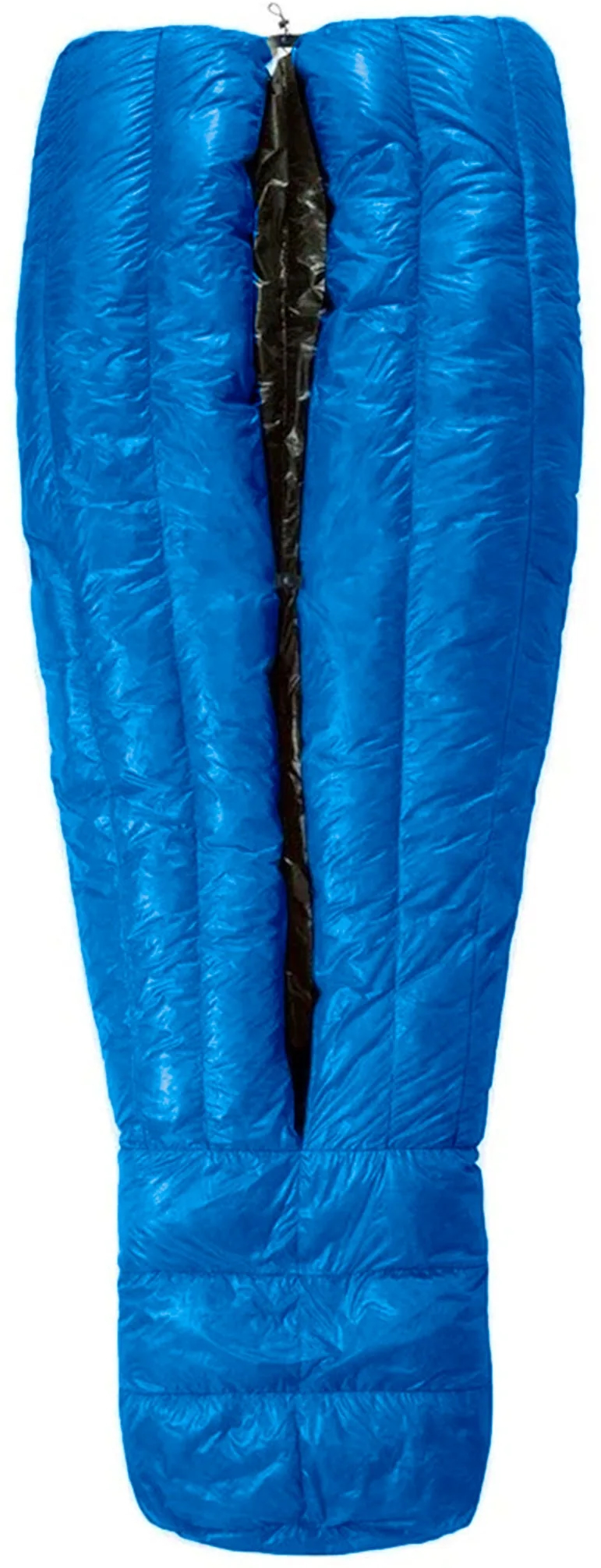 Temperature rating: 20°F
Temperature rating: 20°F
Other options: 10, 30°F
Weight: 1 lb. 2.3 oz.
Fill: 13.7 oz. of 900-fill down
What we like: Great warmth for the weight; lighter than previous model.
What we don’t: The quality of construction on our Solo was pretty poor; less fill and narrower than previous model.
A favorite among thru-hikers, the Zpacks Solo is a standout quilt with a whopping 13.7 ounces of down in a 1-pound-2.3-ounce build. Zpacks uses premium 900-fill down, and you get a generous 55 inches across at the shoulders (or 60 in. if you opt for the “Broad” variation—$459 is the price point for a standard medium), which is slightly narrower than the 57-inch Sea to Summit Ember above but still adequate for ounce-counters. With a center back strap, the Zpacks can wrap around a sleeping pad or cinch closed around your body.
However, while the Zpacks’ specs undeniably are impressive, we were fairly disappointed when we first pulled ours out of the box. Perhaps it was the result of our rush order, but the stitching on our quilt was egregiously bad. More specifically, it zigzagged and revealed exposed ends, and overall looked extremely sloppy—not something we would expect given the steep price tag. To be fair, this was our first negative experience with Zpacks (we’ve found their Arc Blast 55 backpack and Duplex tent to be well made), and many buyers have been happy with the Solo. But the specialty quilt market is highly competitive, and we’ve moved the Zpacks towards the bottom of our list given the quality control issues.
See the Zpacks 20F Solo Quilt
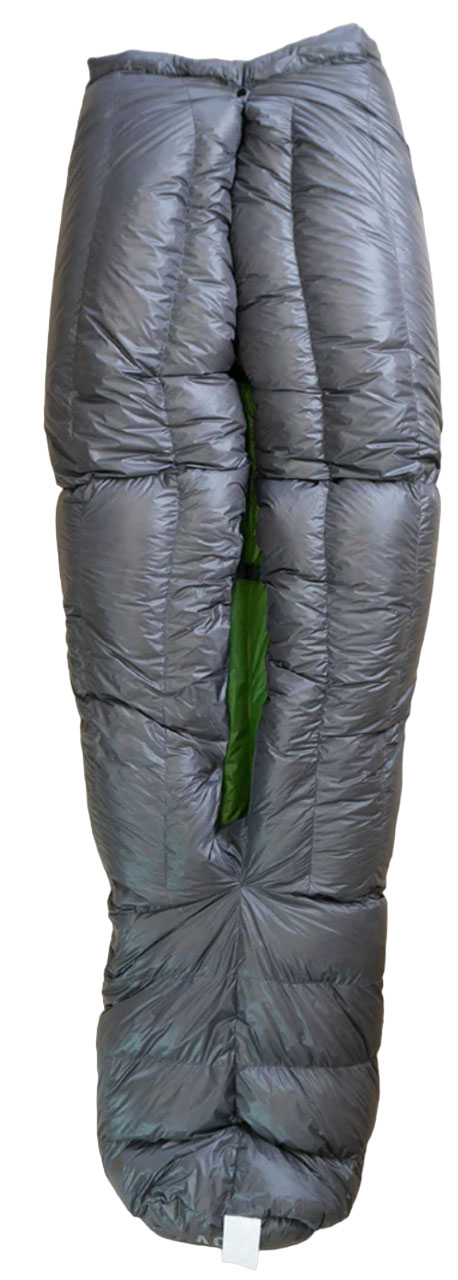 Temperature rating: 15°F
Temperature rating: 15°F
Other options: 0, 30°F
Weight: 1 lb. 7.0 oz.
Fill: 16.2 oz. of 800-fill down
What we like: A low-cost quilt that will get the job done for new backpackers and occasional use.
What we don’t: Lacks the customizations of offerings like the Enigma and Burrow.
A small yet exciting brand coming out of southern Utah, Outdoor Vitals makes a variety of ultralight backpacking gear and apparel. Their StormLoft Down TopQuilt gives a budget design like the Hammock Gear Burrow a run for its money, offering very similar warmth and weight at a similar price point. Compared to the 20-degree Burrow (we outline the 30° above), the StormLoft packs slightly more down (albeit at a lower fill power) and is only 0.5 ounces heavier (with 10D fabric on the Burrow). What’s more, it comes stock with a draft collar (the Burrow lacks an official draft collar) and features a sewn footbox (though the Burrow has the option for a sewn footbox for $10 more) and pad straps, making it a draft-free place to be on chilly nights.
Keep in mind that Outdoor Vitals’ temperature ratings are a bit generous—the 15-degree version here features a similar amount of down as a lot of 20-degree quilts (including the aforementioned Burrow 20). As a result, we wouldn’t push it in cold shoulder-season conditions, although you can also opt for the 0-degree version instead. The StormLoft also only comes in two sizes compared to many options with the Burrow, and the 10D fabric cannot be swapped out for a lighter or heavier variety. And finally, at 1 pound 7 ounces, it's the heaviest quilt on our list (keep each warmth rating in mind, however), aside from the two-person Accomplice below. But if the StormLoft fits your needs in terms of warmth and sizing, it’s a nice low-cost alternative to the pricier offerings here.
See the Outdoor Vitals StormLoft Down TopQuilt
 Temperature rating: 34°F ISO Comfort, 23°F Lower Limit
Temperature rating: 34°F ISO Comfort, 23°F Lower Limit
Weight: 1 lb. 2.0 oz.
Fill: 12.0 oz. of 1,000-fill down
What we like: Strong sustainability focus, decidedly ultralight, and highly packable.
What we don’t: Pricey; cinch system is finicky to use.
Weighing just 1 pound 2 ounces and packing down impressively small, the Nemo Pulse 20/30 stands out as one of the lightest—and most sustainably made—fully featured backpacking quilts on the market. Its clever Karo Step baffle construction keeps the 1,000-fill hydrophobic down evenly distributed while trimming weight compared to more complex baffling systems, helping eliminate cold spots with minimal bulk. Nemo also included premium touches like a plush collar baffle and Cohaesive hardware to help seal out drafts, and the shell is made from 100%-recycled ripstop polyester with a PFAS-free DWR finish—meaning it not only performs well in the backcountry but also leaves a lighter footprint. And once it’s run its course, you can send the quilt back to Nemo for full recycling through their Endless Promise program, making this one of the most eco-concious options in our lineup.
That said, the Pulse doesn’t come cheap at $550, and we found the temperature rating to be a bit optimistic—expect to supplement with extra layers on true 30-degree nights. Additionally, the cinch system at the footbox, while thoughtfully integrated, takes a little more fiddling than other designs. But for dedicated weight-shavers who value smart tech, sustainable construction, and a strong feature set in a featherweight package, the Pulse 20/30 is a compelling new entry in the ultralight quilt market.
See the Nemo Pulse 20/30 Endless Promise Quilt
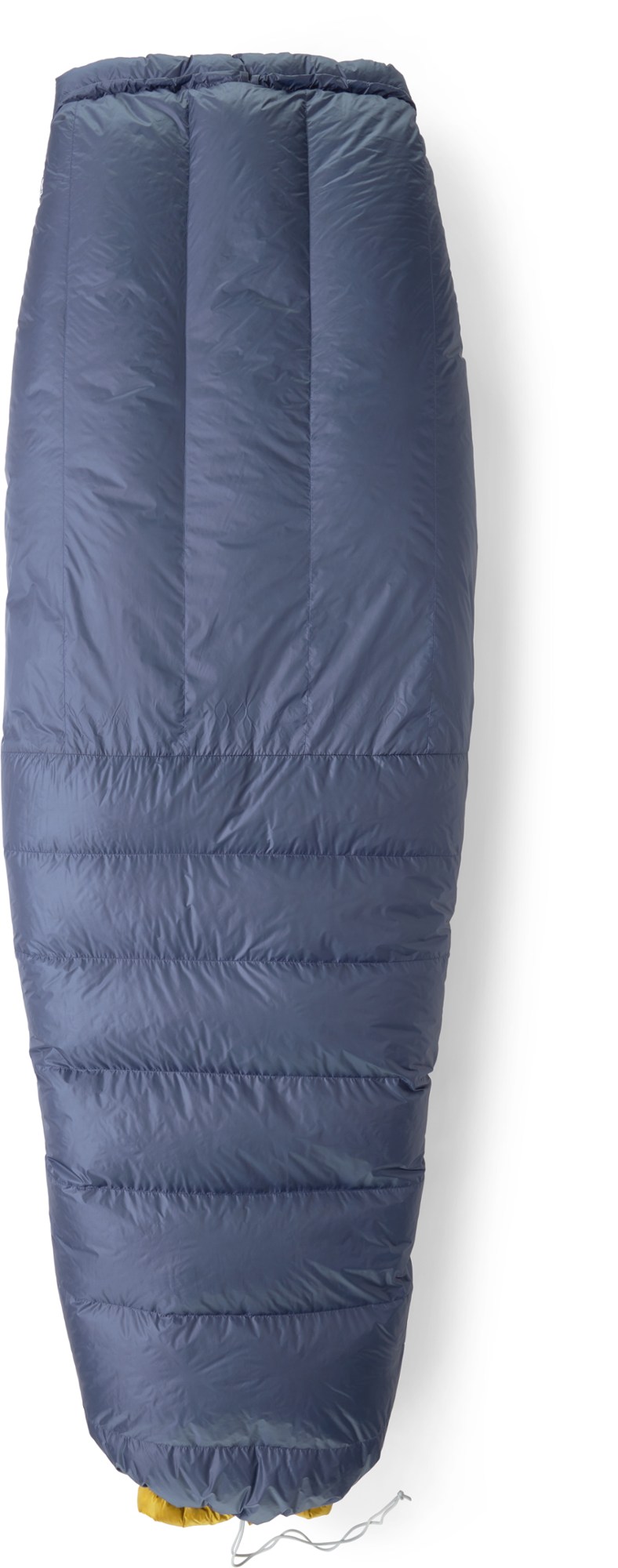 Temperature rating: 30°F
Temperature rating: 30°F
Weight: 1 lb. 4.3 oz.
Fill: 11.6 oz. of 850-fill down
What we like: High-quality materials and a great price.
What we don’t: Heavier than similarly rated quilts.
If there’s a clear sign that quilts are hitting the mainstream backpacking scene, the Magma Trail is exactly that. REI Co-op did a very impressive job with their first quilt, which is a spinoff of their popular sleeping bag line. In terms of warmth, you get a generous 11.6 ounces of 850-fill down and a lofty draft tube that seals air in at the neck. We also like the shape of the footbox, top snap, and overall build quality, which feel high-end from top to bottom. And at $329, the Magma Trail is a great value.
It’s worth noting that you save 4.1 ounces and $50 with the Magma quilt over the mummy bag version above, which may be worth it for many. In the end, your choice comes down to what sort of versatility you prefer: Do you need a full zip to stay comfortable on colder nights or an open back to ventilate when it’s warmer? If you’re willing to pay the weight and price penalties, the full-zip sleeping bags offer the best of both worlds. In the end, if we’re going with a quilt, we’d be tempted to reach for a warmer or lighter option than the Magma. But for a long-lasting pick (the Magma’s 15D shell fabric is one of the most durable here) that’s ready when you want it, this quilt is worth a look.
See the REI Co-op Magma 30 Down Trail Quilt
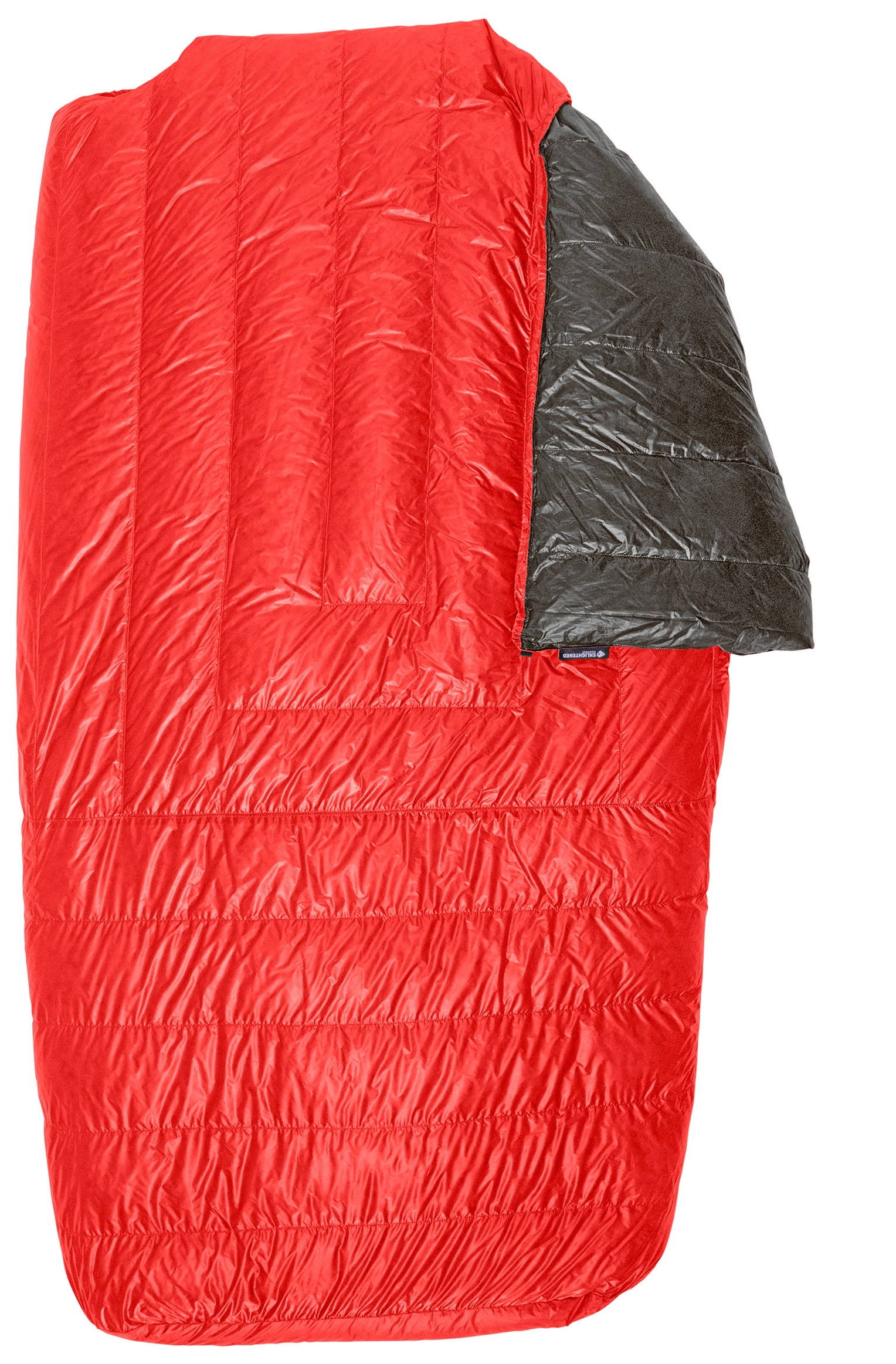 Temperature rating: 20°F
Temperature rating: 20°F
Other options: 0, 10, 30, 40, 50°F
Weight: 2 lb. 4.8 oz.
Fill: 27.8 oz. of 850-fill down
What we like: A warmer, lighter, and cozier alternative for couples; will save you some cash over purchasing two separate quilts.
What we don’t: Can be challenging to seal up drafts; you'll likely have to wait longer for a custom design.
If you commonly travel as a couple, it can be worth considering a two-person quilt. Aside from the obvious benefit of being able to snuggle up with your partner, these double designs have a few advantages over single quilts. For one, they allow you to share body warmth, meaning you can often get away with a higher temperature rating. Second, they’re typically lighter and more packable than two standard quilts combined (for example, two 20°F Enigma quilts weigh 2 lb. 10.4 oz. compared to the Accomplice’s 2-lb.-4.8-oz. build). And finally, they’ll save you a good deal of cash—at $560 for the 20-degree model with a regular length and 850-fill down, the Accomplice is far less than what you'd pay for two 20-degree Enigma quilts ($355 each, or $710 all in).
But as with most things, there are some compromises in opting for a double sleeping quilt. They’re not as easy to vent as standard designs, and sealing up drafts can be difficult with two people. And then there’s the challenge of sharing the load of a double sleeping bag, which cannot be split between two packs (we like to have the person not carrying the double quilt carry more elements of the tent and heavier cooking supplies). But the Accomplice pulls it all off better than most, with premium 850- or 950-fill down (your choice), separate collars that cinch around each neck with a draft blocker in between, and a pad attachment system that works with both single and double sleeping pads. It's important to note that ready-to-ship models can be limited, but the custom Accomplice is a great option for narrowing in on the perfect design for your adventure.
See the Enlightened Equipment Accomplice 20
| Sleeping Bag | Price | Temp* | Weight | Down Fill* | Shell | Zipper |
|---|---|---|---|---|---|---|
| Feathered Friends Hummingbird UL | $549 | 30°F | 1 lb. 5.4 oz. | 11.5 oz. of 950-fill | 10D | Full-length |
| REI Co-op Magma 30 | $379 | 34°F (ISO) | 1 lb. 8.4 oz. | 12.7 oz. of 850-fill | 15D | Full-length |
| Feathered Friends Tanager 20 CFL | $469 | 20°F | 1 lb. 2.6 oz. | 12.6 oz. of 950-fill | 7D x 5D | None |
| Sea to Summit Spark 45 | $349 | 51°F (ISO) | 12.8 oz. | 5.3 oz. of 850-fill | 10D | 1/2-length |
| Western Mountaineering HighLite | $435 | 35°F | 1 lb. 0 oz. | 8.0 oz. of 850-fill | Unavail. | 1/2-length |
| Montbell Seamless Down Hugger 800 | $385 | 39°F (ISO) | 1 lb. 2.7 oz. | 800-fill down | 10D | Full-length |
| Western Mountaineering UltraLite | $610 | 20°F | 1 lb. 13 oz. | 16.0 oz. of 850-fill | 12D | Full-length |
| Zpacks 20F Classic | $459 | 20°F | 1 lb. 2.8 oz. | 13.7 oz. of 900-fill | 7D | 3/4-length |
| Western Mountaineering SummerLite | $495 | 32°F | 1 lb. 3.0 oz. | 9.0 oz. of 850-fill | 12D | Full-length |
| Mountain Hardwear Phantom 30F | $480 | 30°F | 1 lb. 5.1 oz. | 10.0 oz. of 850-fill | 10D | Full-length |
| Therm-a-Rest Ohm 20F | $490 | 32°F | 1 lb. 6.0 oz. | 12.5 oz. of 900-fill | 10D | Wraparound |
| Feathered Friends Vireo UL | $429 | 25/45°F | 15.5 oz. | 8.7 oz. of 950-fill | 10D | None |
*Editor's note: For the purposes of this table, we have included the EN/ISO Comfort rating where applicable, which we feel is the most accurate point of comparison. When available, we've listed both the Comfort and Lower Limit in the product specs above. For more on the differences, see our buying advice below.
| Backpacking Quilt | Price | Temp | Weight | Down Fill* | Shell | Footbox |
|---|---|---|---|---|---|---|
| Enlightened Equipment Enigma 20 | $355 | 20°F | 1 lb. 5.2 oz. | 15.5 oz. of 850-fill | 7/10/20D | Sewn (zip avail.) |
| Hammock Gear Burrow 30 | $305 | 30°F | 1 lb. 4.7 oz. | 11.6 oz. of 850-fill | 10/20D | Zip (sewn avail.) |
| Feathered Friends Flicker UL | $499 | 30°F | 1 lb. 6.0 oz. | 11.6 oz. of 950-fill | 10D | Full zipper |
| Western Mountaineering NanoLite | $420 | 38°F | 13.3 oz. | 6.5 oz. of 850-fill | 7D | Sewn |
| Katabatic Gear Palisade 30 | $349 | 30°F | 1 lb. 3.8 oz. | 12.0 oz. of 850-fill | .85 oz/yd | Sewn |
| Hyperlite Mountain Gear 20 | $499 | 20°F | 1 lb. 4.1 oz. | 14.0 oz. of 1000-fill | 7D | Sewn |
| Zenbivy Ultralight Quilt + Sheet | $488 | 10°F | 1 lb. 3.7 oz. | 900-fill | 10D | Sewn |
| Sea to Summit Ember 30 | $429 | 30°F | 1 lb. 3.2 oz. | 12.3 oz. of 850-fill | 10D | Drawcord |
| Zpacks 20F Solo Quilt | $459 | 20°F | 1 lb. 2.3 oz | 13.7 oz. of 900-fill | 7D | Sewn |
| Outdoor Vitals StormLoft 15° | $340 | 15°F | 1 lb. 7.0 oz. | 16.2 oz. of 800-fill | 10D | Sewn |
| Nemo Pulse 20/30 Endless Promise | $550 | 34°F | 1 lb. 2.0 oz. | 12.0 oz. of 1000-fill | 10D | Sewn |
| REI Co-op Magma 30 Trail Quilt | $329 | 30°F | 1 lb. 4.3 oz. | 11.6 oz. of 850-fill | 15D | Sewn |
| Enlightened Equipment Accomplice | $560 | 20°F | 2 lb. 4.8 oz. | 27.8 oz. of 850-fill | 7/10/20D | Sewn |
*Editor's note: All of the bags and quilts on our list use responsibly sourced down, meaning that the birds were not force-fed or live-plucked in the process.
Aside from a tent and backpack, your sleeping bag or quilt is the heaviest, bulkiest element of your backpacking loadout. An ultralight model is vital for reducing base weight to hike and climb efficiently—which is just what our team of trail hogs at Switchback are all about. From fast and light weekend missions in the mountains to full-blown thru-hikes up and down the country, we've clocked our fair share of miles toting all manner of ultralight sleep systems and are constantly trying to find that perfect balance between warmth and a minuscule scale reading. In short, only the absolute best quilts or bags out there are considered for this guide. Former senior editor Jenny Abegg first wrangled this list together back in 2019. A dedicated mountaineer and ultralight backpacker, she is intimately familiar with the importance of a lightweight load for tackling serious miles in the backcountry. She took countless bags and quilts out on just as many adventures around the world to narrow in on our our initial selection of 22 models.
Current senior editor Chris Carter inherited this guide in 2024, and our list now spans 25 options. An avid thru-hiker and climber, Chris' adventures require absurdly small packs and a healthy amount of type-2 fun. His toothbrush is chopped nearly to the bristles, and he's considered just about every ultralight quilt out there in pursuit of the lowest base weight possible. Chris is an alumnus of each of the Triple Crown trails in the United States (AT, PCT, and CDT) and continues to trek and climb around the world. In managing this guide, we analyze a variety of key factors—including warmth-to-weight ratio, packability, and durability—to gauge a quilt or bag's merit. We work hard to stay on top of new models and designs as they surface, adding standouts to our list along the way and ensuring that our existing reviews stay up-to-date in the process.
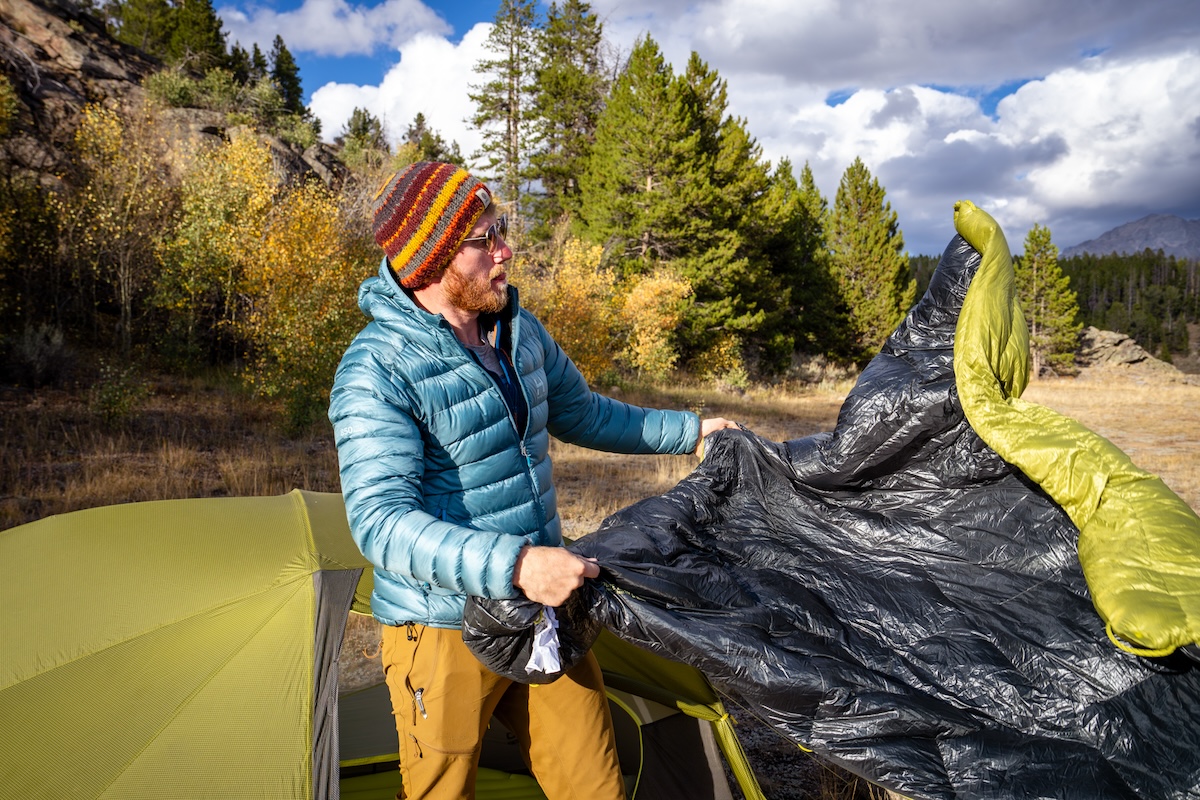
Increased popularity in ultralight backpacking and bikepacking has led to a great deal of innovation in lightweight gear. Outdoor gear companies have found new ways to shave weight off traditional mummy bags, in addition to developing minimalist backpacking quilts. Although there is variation within each style and some crossover in designs, we’ve broken down our picks into two main categories: sleeping bags and backpacking quilts. Below we detail the main features of each, including how they compare in terms of warmth, weight, versatility, and more.
It's worth noting that this guide focuses specifically on niche ultralight sleeping bags and quilts. For a more general selection of sleeping bags, check out our exhaustive guides on the best backpacking sleeping bags and the best camping sleeping bags.
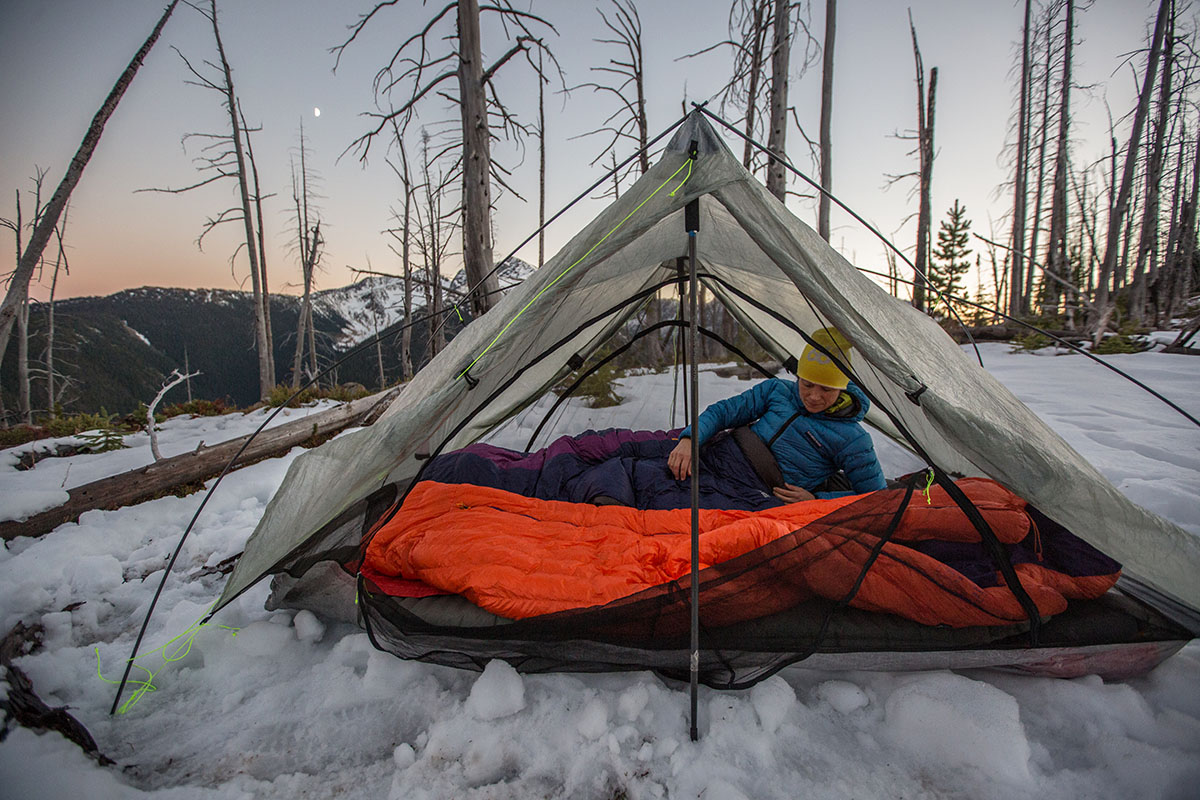
Sleeping Bags
If you’ve done much backpacking, you're probably familiar with mummy-style sleeping bags. Mummy bags are narrow at the feet, widen at the hips and shoulders, and usually have a hood that extends over the head and cinches tight around the face to seal out cold. And while the contoured design of mummy bags means they’re already rather streamlined (compared to more traditional rectangular bags), ultralight styles shed even more weight with thinner shell materials, higher fill power down, shorter zippers, and smaller dimensions. Some mummy bags will even drop the hood and zipper entirely, but expect to sacrifice warmth, comfort, and versatility with these hoodless designs. The ultralight mummy bags on our list have temperature ratings from around 20 to 40 degrees Fahrenheit and weigh between 12.8 ounces and 1 pound 13 ounces, with most hovering just over 1 pound.
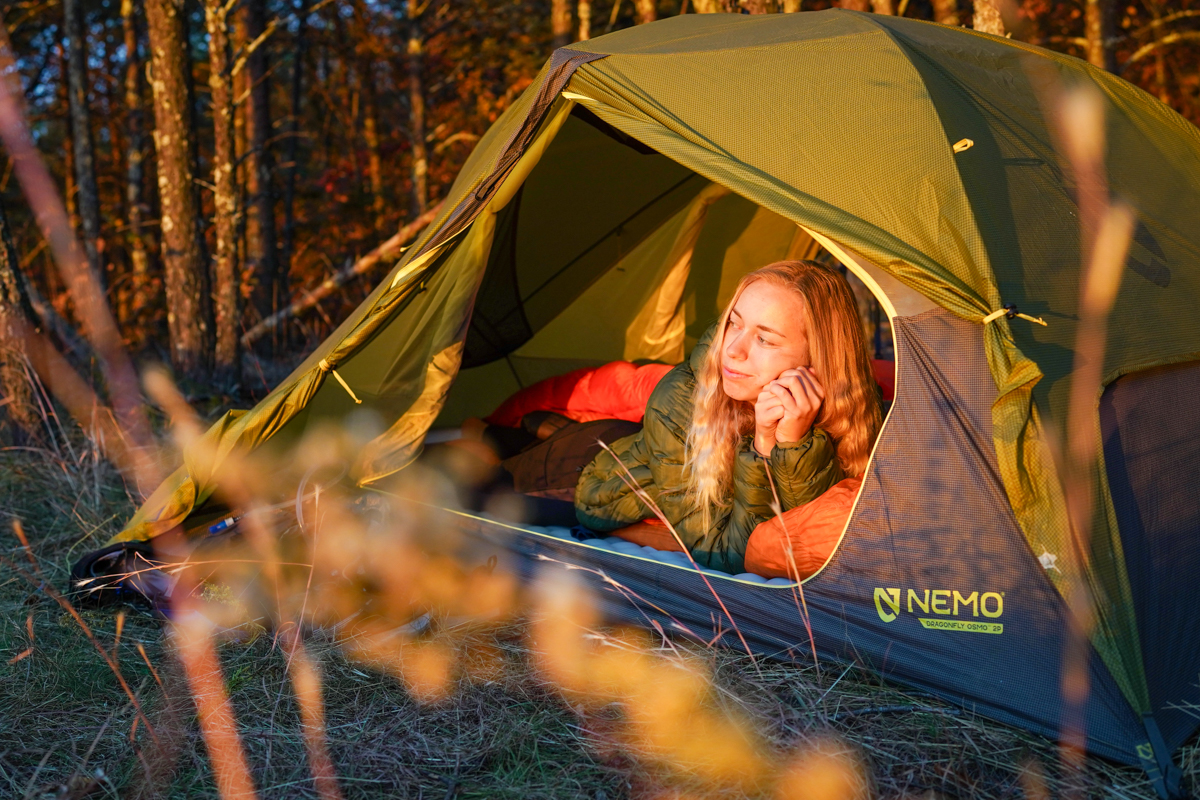
Sleeping bags differ from backpacking quilts in one significant way: they wrap fully around and enclose your body, whereas quilts generally cover only your top and sides (more on this below). Many ultralight sleeping bags use a zipper to cinch all the way closed, while others, like the Feathered Friends Tanager, drop the zipper for a simple slip-on “tube.” Because they provide wraparound protection, sleeping bags generally are a bit heavier than quilts, but they’re also slightly warmer. But while those with full-length zippers offer ventilation similar to a quilt, we find that zipperless bags or bags with shortened zippers are much less versatile. In the end, choosing your style of sleep system comes down to personal priorities, but mummy bags generally are our top choice for cold-weather endeavors when you need the ability to cinch your bag shut and keep out drafts.
Backpacking Quilts
Thru-hikers and diehard ultralighters always are looking for ways to shave ounces, and the backside of a sleeping bag is an obvious target (your bag’s feathers compress underneath you as you sleep, meaning that they don’t actually provide much insulation). A quilt removes the hood and back from a traditional mummy bag and pairs with a sleeping pad (attached via ties or straps) for insulation on all sides. Some quilts are wide enough to wrap fully around the body (with ties to close the gap), while others (“top quilts”) are designed to protect only the sleeper’s top and sides. In terms of the footbox, quilts will either feature a sewn-shut box or a blanket-style design with a drawcord cinch or zipper at the feet. Like ultralight sleeping bags, quilts prioritize weight savings with high-fill-power down, thin shell fabrics, and lightweight attachment systems. Our top quilt picks range from 13.3 ounces to 1 pound 7 ounces, with most models clocking in around 1 pound.
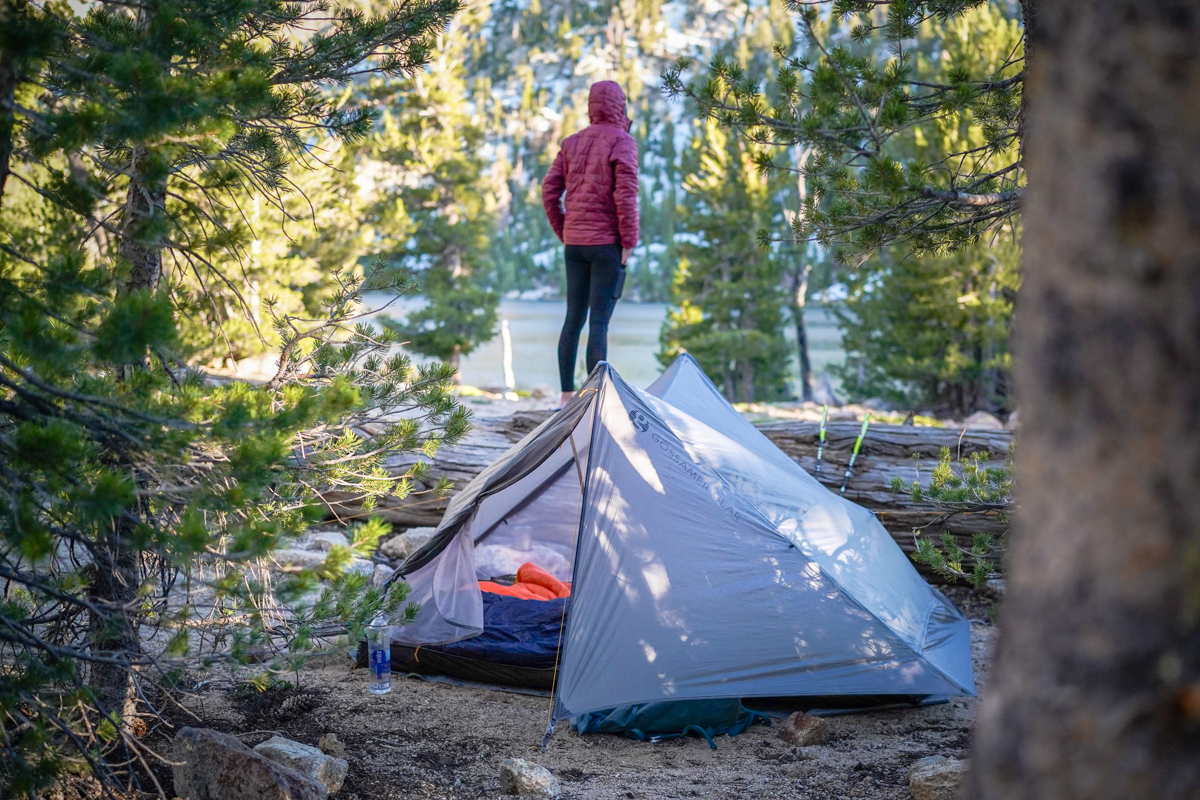
While the quilts on our list have temperature ratings similar to our top sleeping bag picks (20 to 40°F), there are a few factors to consider here. First off, unless you’re a perfectly still back sleeper, quilts have a higher potential for drafts, which throws a wrench in the temperature rating. But to compensate, most designs contain a bit more down fill than traditional bags (and remember, it’s concentrated on the front and sides, which means even more warmth). For example, the 20-degree Therm-a-Rest's popular Hyperion (out of stock at the time of publishing) sleeping bag has 12.5 ounces of 900-fill down, while the 20-degree Feathered Friends Flicker UL has 14.7 ounces of higher-quality 950-fill down. And on warmer nights, quilts offer much better ventilation than sleeping bags. Finally, by doing away with the zipper and a whole side of materials, quilts often are a bit lighter too (consider the 13.3-oz. Western Mountaineering NanoLite).
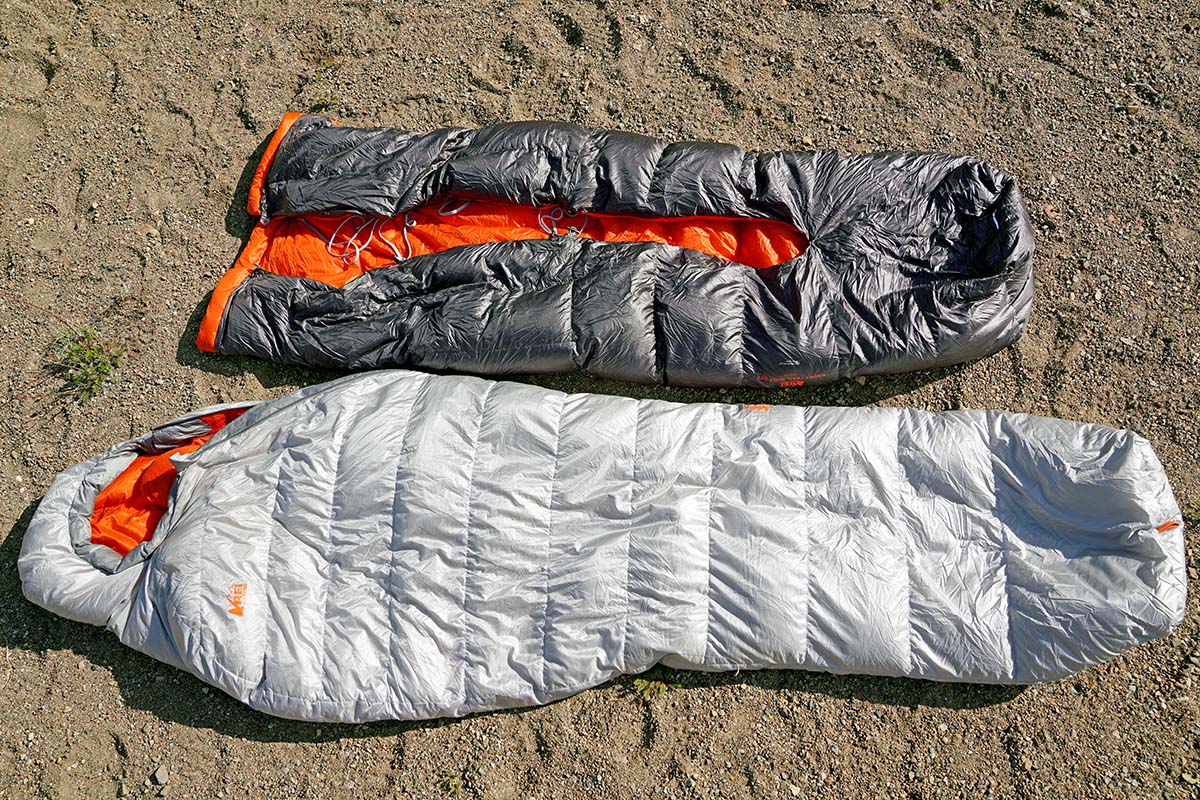
Hybrids
It’s worth mentioning that there is a tiny subgroup of sleeping bag/quilt hybrids that retains many characteristics of both. For example, the hybrid Feathered Friends Flicker UL features a full-length zipper that extends all the way through the footbox. On cold nights, the Flicker encloses your body completely, à la sleeping bag (a cinch tightens the footbox to minimize cold air spots), and on warm nights it opens all the way up into a blanket. Another hybrid option is the Therm-a-Rest Ohm, which features a more roomy, semi-rectangular shape that opens up into a quilt for two. These hybrid options are super versatile ultralight sleep systems that cross over from cold to warm better than most, but keep in mind that the full-length zipper does add some weight. For example, the 30-degree Flicker is 1 pound 6 ounces compared to the 1-pound-5.4-ounce Hummingbird sleeping bag and 1-pound-3.8-ounce Katabatic Gear Palisade quilt (both also 30°F). For a more detailed breakdown of the categories mentioned above, see our article on sleeping bags. vs. quilts. Another unique hybrid option is the popular Zenbivy Ultralight Bed, which pairs a quilt and sheet together in one streamlined package.
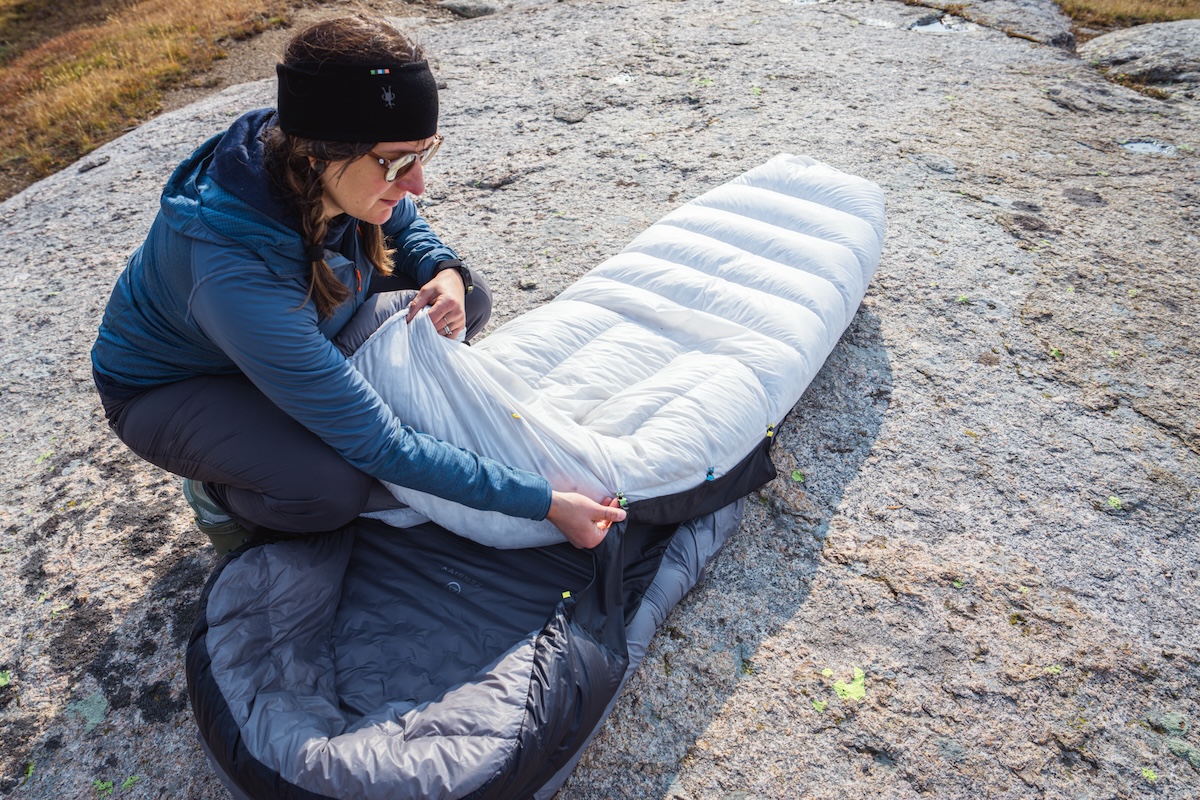
Ultralight sleeping bags and quilts are specifically designed for weight- and space-conscious backpackers, thru-hikers, alpinists, and bikepackers. Every sleeping bag and quilt we’ve included on our list above is under 2 pounds, aside from Enlightened Equipment's two-person Accomplish (most models hover just over 1 lb.), which is pretty impressive considering the amount of warmth they provide. And because all of these bags and quilts are insulated with down rather than synthetic fill, they pack down incredibly small. Some come with a compression sack, but if not, we highly recommend purchasing one separately. With that, many of these bags and quilts can compress roughly to the size of a Nalgene bottle, easily fitting into a corner of your backpacking pack or bike pannier.
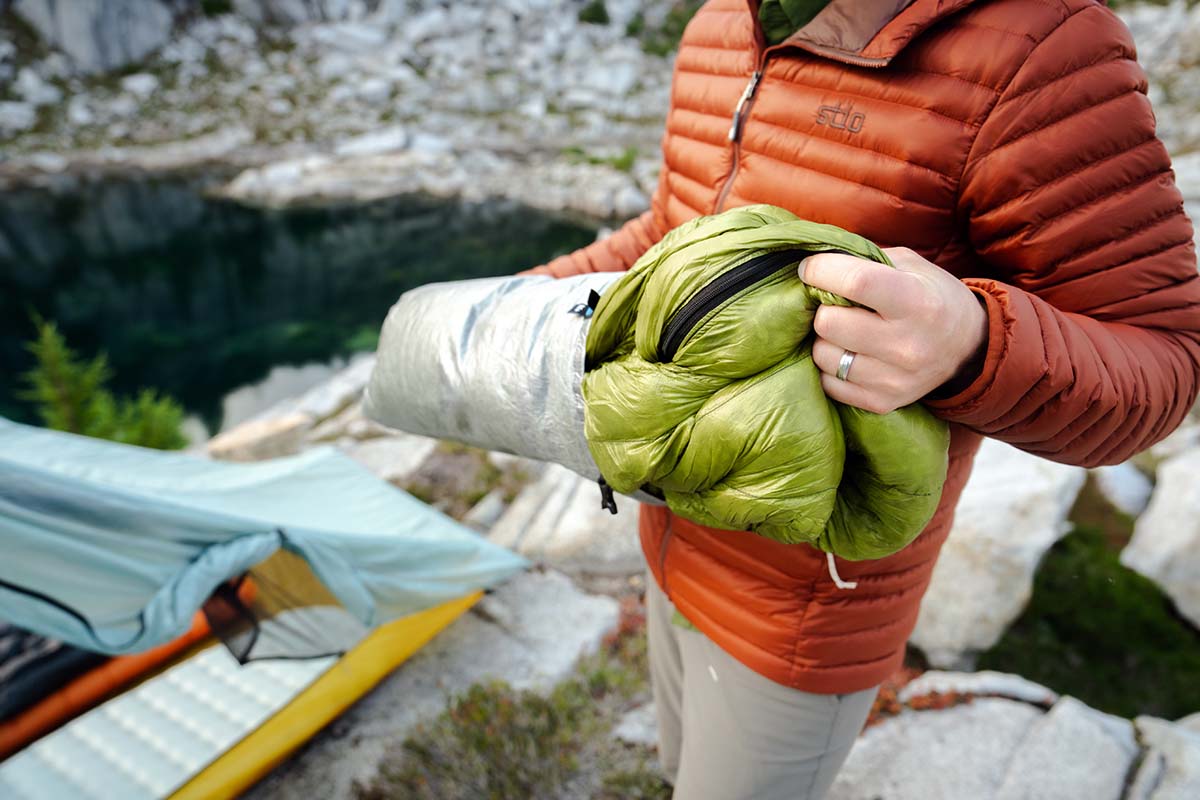
As we mentioned above, manufacturers shave weight from sleeping bags and quilts in a number of ways, including the use of ultra-thin shell fabrics (measured in denier), high-fill-power down (which offers impressive warmth for the weight), thin or shortened zippers (or none at all), and narrow profiles. Other designs eliminate the hood or footbox or include less down fill along the torso. In the case of quilts, some also leave off attachments or cinches (these are often known as “top quilts”). It’s important to keep in mind that, inevitably, a lighter sleeping bag or quilt will often result in sacrifices in durability, comfort, or warmth (or all of the above).
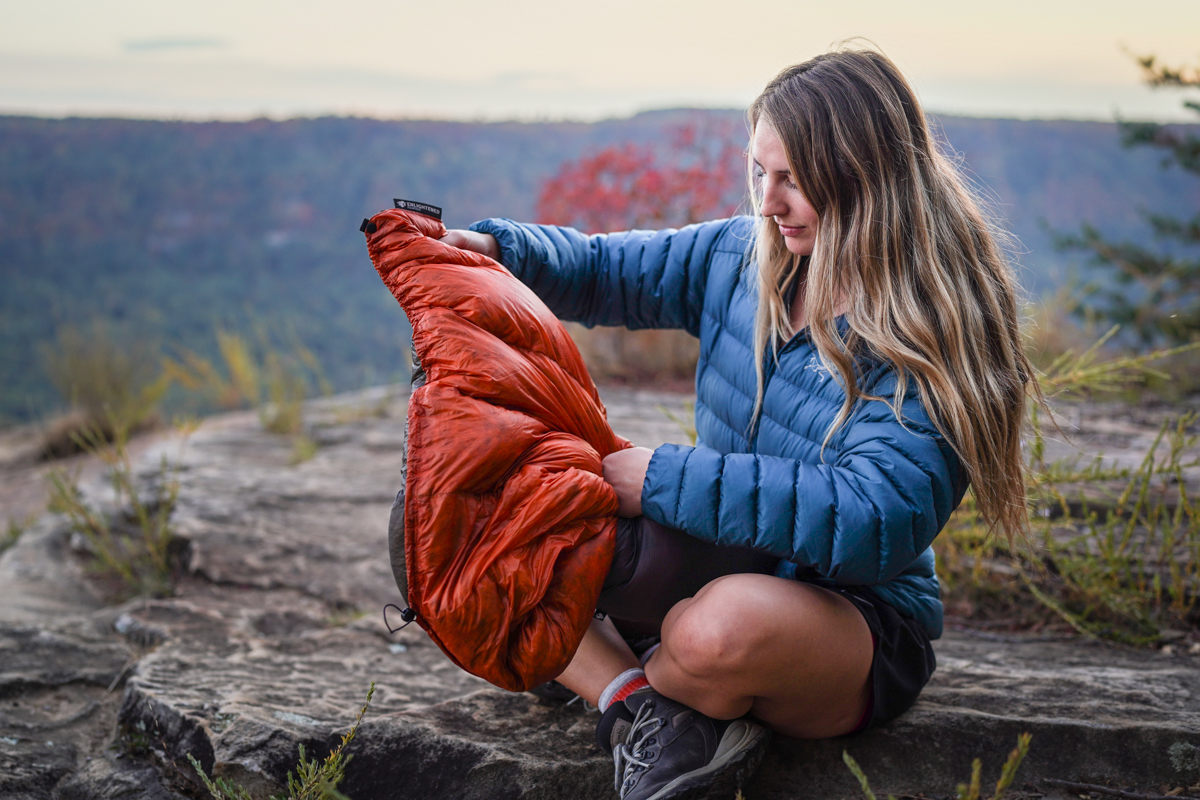
For example, consider the 1-pound-5.4-ounce Feathered Friends Hummingbird and 1-pound-2.6-ounce Tanager. While you’d expect the heavier model to be warmer, in this case, the Tanager is the warmer bag (by 10 degrees), with 12.6 ounces of 950-fill down vs. the Hummingbird’s 11.5. How does the Tanager accomplish this? The short answer is that the bag sacrifices both convenience and durability, with a hoodless and zipperless design and very thin shell fabric. The lesson here is that a lower weight does not always mean a less insulated bag—but it does indicate that some sacrifices are being made. In the end, it’s important to look at the specific features of each bag, which we've tried to detail above, and decide what and how much you’re willing to give up for a few ounces of weight and space. If you'd like to explore further, check out our sleeping bag weight comparison chart for a side-by-side look at most of the top contenders on the market.
One of the first things you might notice about the ultralight sleeping bags and quilts featured in this article is their insulation: every item on our list uses down fill. This is a notable departure from our traditional sleeping bag round-up, where we have a solid mix of down and synthetic options. But in an ultralight category, down is by far the superior insulator, beating out synthetic fill both in warmth-to-weight ratio and compressibility.
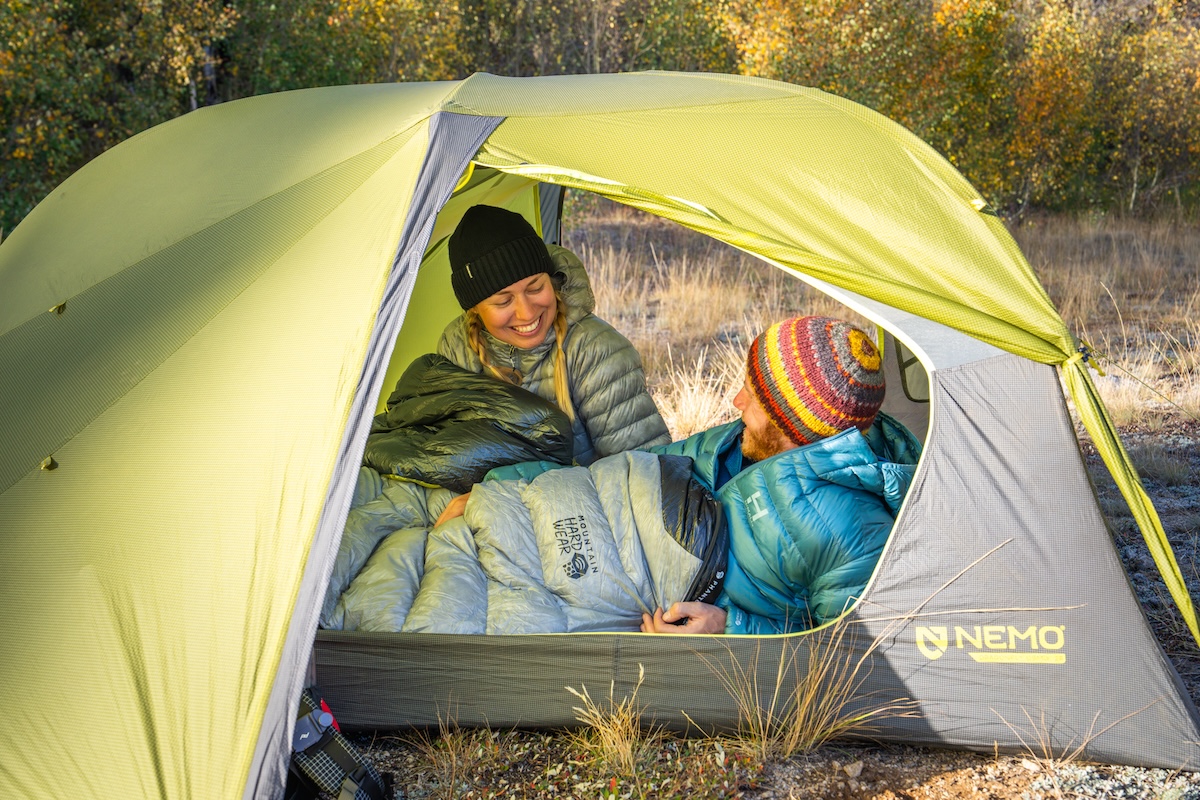
That said, not all down insulation is created equal. Both duck and goose down are measured in terms of their fill power, which describes (in cubic inches) how much space is filled by one ounce of down. Fill power can vary from around 500 to over 900, with most ultralight sleeping bags and quilts featuring a fill power of 850 to 950. A second measurement you’ll commonly see is fill weight, which is the total weight (in ounces) of the amount of down in a product. For example, the REI Co-op Magma 30 has 12.7 ounces of 850-fill goose down. Be sure to pay attention to both numbers—a higher fill power doesn’t always indicate a warmer product, and fill weight is the lesser-advertised but perhaps more important spec of the two. In the end, you need both to get an accurate idea of how warm a given bag is.
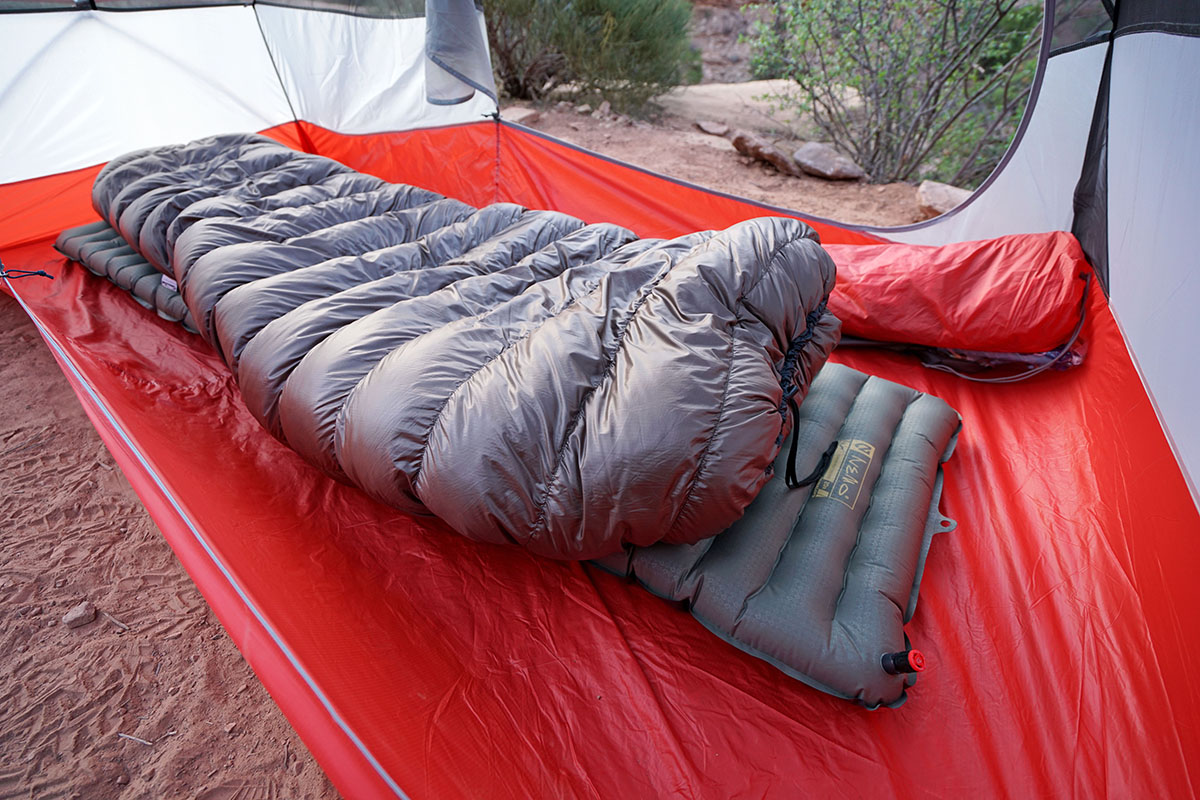
When it comes to ultralight bags, temperature ratings are a bit like the Wild West. Some companies here adhere to international testing standards (you'll see mention of EN or ISO ratings), while many of the smaller brands choose to provide their own temperature ratings. Quilts, in particular, do not qualify for standardized tests given the nature of their open design. For a deeper dive into this topic, see our article on sleeping bag temperature ratings.
For the consumer, the primary benefit of EN/ISO ratings is the ability to draw accurate comparisons between products. It's a bit trickier comparing an EN/ISO-rated bag with a non-rated bag, but there are a lot of helpful clues to keep in mind. For one, down fill power and weight are great indicators of how warm the bag will be, in addition to the construction (sewn-through or baffled) and whether or not the bag comes with a hood and draft collar. And as for models that don't undergo standardized testing, we've found that most small companies take pride in providing fairly conservative temperature ratings. For example, the Feathered Friends Hummingbird UL 30 is warmer than most bags with a 30-degree EN/ISO Comfort designation (more on this below).
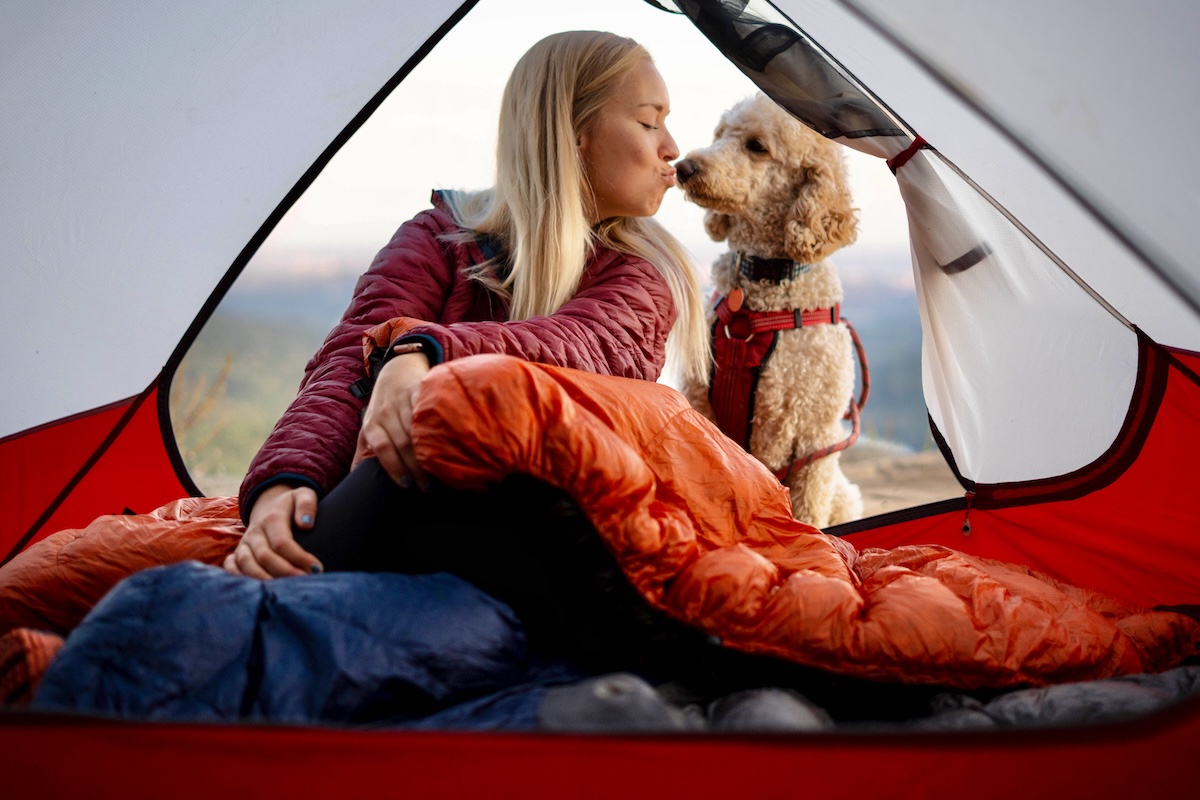
You'll also notice that EN/ISO-rated bags are given both Lower Limit and Comfort ratings. The Lower Limit indicates the temperature at which the bag or quilt will keep you safe—for men’s bags, this usually is the given temperature rating (or close to it). The Comfort rating denotes at what temperature the bag will keep you comfortable, and this is the number often specified for women’s bags. In practice, we've found the Comfort rating to be the most accurate predictor of warmth, which is why we've listed it (where applicable) in the comparison table above. And it's never a bad idea to err on the conservative side, giving yourself a buffer (10 degrees or so) between your bag's Comfort rating and the low temperatures you expect to be sleeping in.
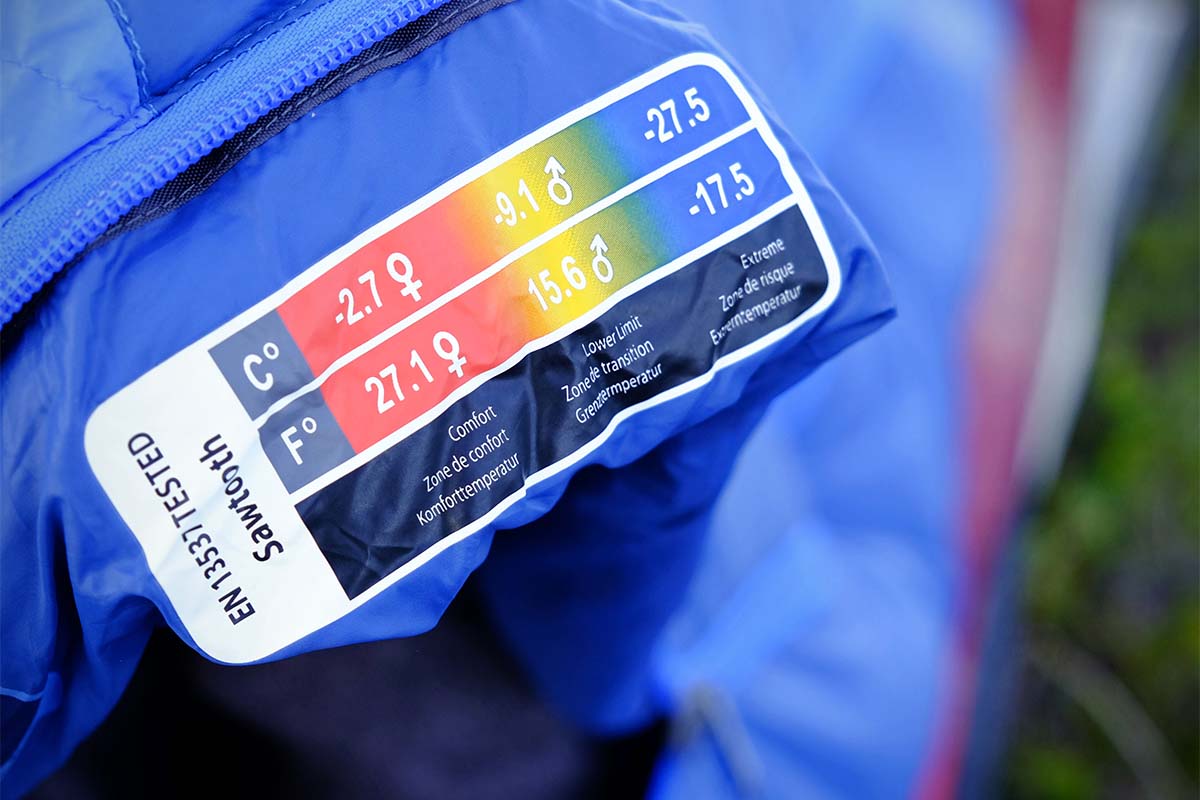
We can talk about the insulation of a sleeping bag or quilt all day, but without a shell and lining, a sleeping bag would just be a pile of plumage. Typically, ripstop nylon is used for both the outer shell and inner lining, and the thickness of this nylon is specified in denier or "D" (the thickness of each thread used to create the material). Generally speaking, the higher the denier, the more durable the fabric.
One way that manufacturers shave weight off ultralight sleeping bags and quilts is by using extremely thin shell fabrics, which can go as low as 7D (or in the case of the Feathered Friends Tanager, 5D by 7D). These products require an extreme amount of care—with thousands of feathers loose inside, a small rip can mean the loss of a lot of insulation. We’ve had our fabric rip due to a snagged zipper, but you’ll also need to be careful around twigs, rocks, and sharp items in your pack. If you’re sleeping without a tarp or tent, make sure to clear the ground of any abrasive objects. Further, we recommend always stowing or packing your bag in a stuff sack or cloth bag for transport or storage.

If you tend to be rough on your gear, it’s a good idea to choose a sleeping bag or quilt with more durable fabric. Many of the items listed here come with the option of a thicker face fabric. Hammock Gear, for example, offers the 20D Burrow in addition to the 7D Burrow UL. Similarly, the Feathered Friends Hummingbird YF is made with a 20D shell fabric compared to the Hummingbird UL’s 10D. The endlessly customizable Enlightened Equipment Enigma allows you to choose between a variety of different fabric color options of 7D, 10D, or 20D. Heavier fabrics will cost you a small weight penalty but may end up being worth it in the long run.
Sleeping bags and quilts come in a range of sizes, which generally are specified by length. The Feathered Friends Hummingbird bag, for example, is available in regular and long sizes. Manufacturers also specify the girth—or circumference—of each size, most commonly given as a series of three measurements taken at the shoulders, hips, and footbox. Cottage brands like Enlightened Equipment and Katabatic are known for offering more choices in terms of sizing, especially when it comes to width. For example, our top-ranked Enigma quilt is available in 16 different variations, ranging from short to extra-long for length and slim to extra-wide for width. This high degree of customization makes quilts a great choice for plus-sized backpackers, who might not find what they need in the traditional sleeping bag market.
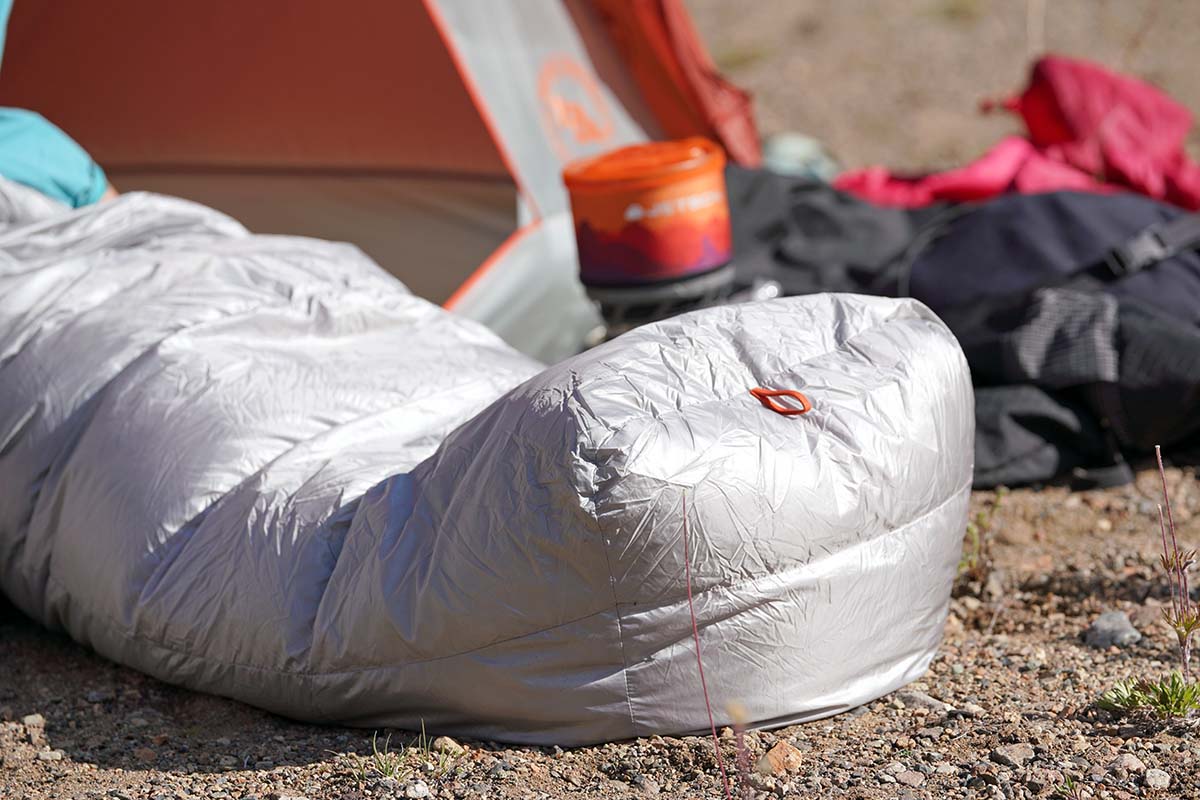
Ultralight bags and quilts are often much more streamlined (read: narrower) than their traditional counterparts. For example, compare the Feathered Friends ultralight Hummingbird UL 30 to their roomier (and heavier) Swallow UL 30. The Hummingbird (1 lb. 5.4 oz.) measures 58 inches around the shoulders, 52 at the hips, and 38 in the footbox, while the Swallow (1 lb. 9 oz.) is 60, 56, and 38 inches, respectively. The UL versions of the Hummingbird and Swallow are virtually identical aside from their measurements and weights. And keep in mind that shoulder girths between sleeping bags and quilts don't quite compare—for example, Katabatic Gear states that their size-regular Palisade quilt (54 in. at the shoulders) is comparable to a sleeping bag with a shoulder measurement of 63 inches.
While cutting a bag’s dimensions is effective for minimizing the total weight of the product, it can be a pain for those with broad shoulders and wide hips or for side sleepers. If you consider yourself in either category, we recommend looking at wider or roomier options. In the ultralight realm, the Down Hugger lineup from Montbell is a great choice, featuring spiral baffles that allow for stretch in the fabric. Quilts also can offer a nice solution for those who feel constrained by a sleeping bag, but their narrow dimensions pose a whole different issue—if you do want to batten down the hatches, there might not be enough fabric to wrap fully around your body. For the best of both worlds, look for quilts with generous shoulder dimensions that are wide enough to cinch closed. Alternatively, you might also consider opting for a double quilt, which typically measure around 86 inches at the shoulders and are available from brands like Enlightened Equipment and UGQ.
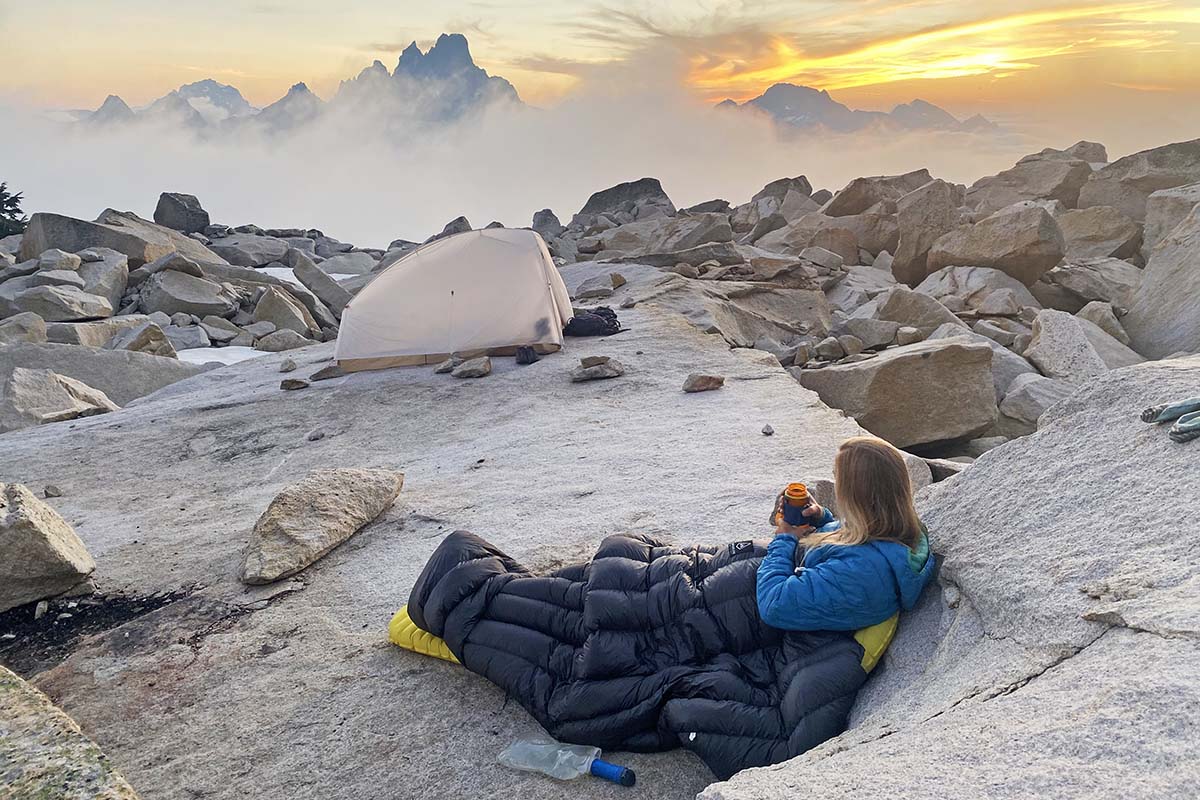
Rear Closure
Backpacking quilts, by design, forgo the zipper closure of a traditional sleeping bag and leave the back open, draping over the sleeper like a blanket or attaching to the sleeping pad. Some are so narrow that they are unable to fully enclose a body (think hot dog bun), while others, like the Zpacks Solo Quilt, are wide enough that the two sides can meet (more akin to a taco). On these wider quilts, it’s common to see a closure along the backside, which means the quilt can be securely closed, mimicking a sleeping bag. Feathered Friends’ Flicker UL is also a notable exception here, as it has a full-length zipper to seal shut (although it’s heavier than much of the competition).
.jpg)
The most common closures we see on quilts are 1-3 clips or buckles along the sides. The Western Mountaineering NanoLite innovates with a thin, crisscrossed elastic band across the back. While these closure systems cannot be expected to fully seal out drafts, they do ensure that the quilt will stay wrapped around you while you sleep (unless you’re using sleeping pad attachments, which we think is a better option for ground sleepers). It’s important to think about your end-use when considering what kind of closure system you want—if you need one at all. For example, the elastic back of the NanoLite is super lightweight and comfortable under the body, but with no quick release, the quilt cannot be used like a blanket. On the other hand, buckles like those on the Enlightened Equipment Enigma might feel uncomfortable against your back, and we have concerns about their long-term durability. Finally, if you don’t think you’ll use it, you might want to opt for a model with no rear closure (also called a top quilt).
Sleeping Pad Attachments
More than a rear closure, the design of a quilt relies on sleeping pad attachments to keep drafts out. Sleeping pad attachments extend from the back of the quilt and around the pad and generally offer two adjustments. First, cinch the straps to the pad for a secure attachment. Second, choose where to lock your quilt in on the straps. You can lock each side towards the center for more draft protection or closer to the sides for a roomier sleep. And on a warm night, leave the attachments off for better ventilation. Sleeping pad attachments differ from brand to brand and offer varying levels of weight savings, convenience, and durability.
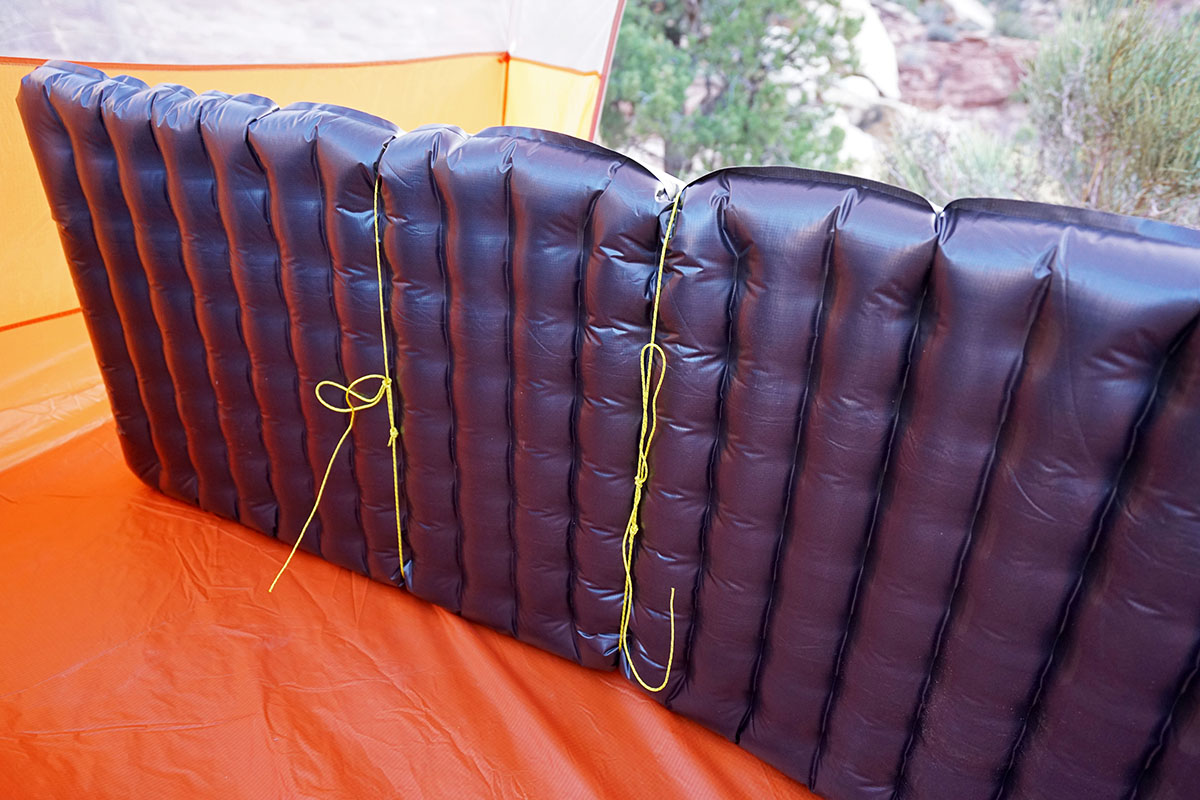
Footboxes: Sewn and Open
The footbox is one of the main places we see quilts differ in style and design. Take the Enlightened Equipment Enigma and Revelation, for example. The Enigma features a sewn-shut footbox, whereas the Revelation has a zipper and drawcord that allow you to open the quilt to a full blanket. Other quilts feature a snap and drawcord closure instead. And on hybrid sleeping bag/quilts like the Feathered Friends Flicker, we see a full-length zipper that extends all the way through the toe box to give you the ultimate versatility (at a weight penalty).
The advantages and disadvantages to each design are fairly obvious. With an enclosed footbox, you get a very simple design with no moving parts and a draft-free compartment for your feet. However, you don’t get the option of opening your quilt up into a blanket. With the open footbox, on the other hand, you get a lot of customization, but at the sacrifice of weight and a bit of warmth (although you can always stuff your jacket into the footbox to minimize drafts). The trend seems to be moving toward sewn-shut footboxes (most users don’t find a need for a blanket), but many cottage-industry models, including the Hammock Gear Burrow, allow you to choose between a sewn or zippered/drawcord footbox.
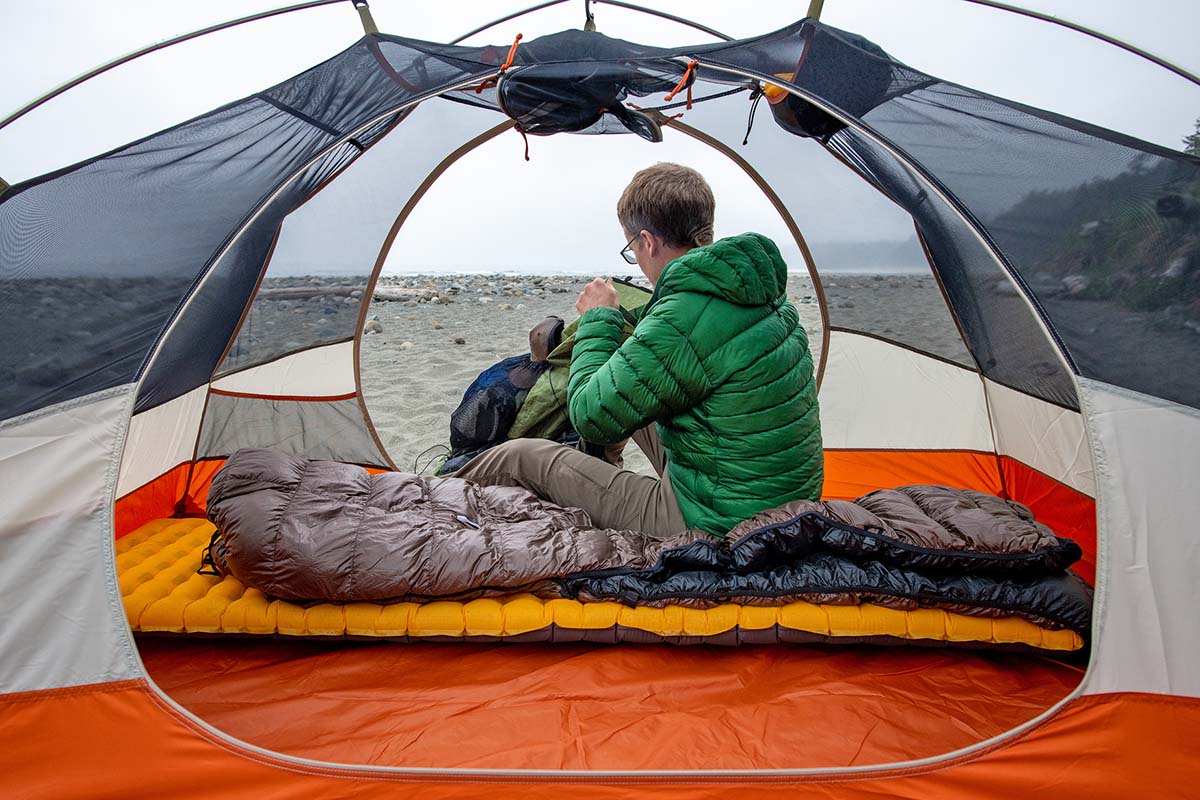
Zippers
Zippers are one of the heaviest features on a sleeping bag, so it’s no surprise that this is a place where we see a great deal of variation and innovation in the ultralight world. For one, manufacturers can cut weight by shortening the length of a zipper: while some ultralight sleeping bags feature zippers that extend the entire length of the bag (REI Co-op Magma), others have partial-length zippers (the Sea to Summit Spark) or forgo the zipper entirely (Feathered Friends’ Tanager and Vireo).
.jpg)
Full-length zippers not only offer ease of entering and exiting the bag, but they also allow versatility in venting. On a hot night, it’s nice to be able to stick a leg out into the cool air or zip open the bag and drape it overtop like a blanket. Two-way zippers offer even more versatility, allowing you to cool off hot feet while keeping the torso completely insulated. On the other hand, partial-length zippers or zipper-less designs mean your ventilation options are severely limited. We’ve spent many nights in our Therm-a-Rest Hyperion 20 (out of stock at the time of publishing) bouncing back and forth from too hot (fully inside the bag) to too cold (bag draped overtop) with no viable middle ground.
Another way that manufacturers shave weight is by using thin zippers (often as low as #3 YKK). But keep in mind that thinner zippers are less durable and trickier to use than their more robust counterparts. Our old Mountain Hardwear Mtn Speed 32, for example, had a #3 YKK zipper that rarely shut without issue, eventually resulting in a large rip in the shell fabric beside it, leaking down, and broken teeth (thankfully, Mountain Hardwear repaired the sleeping bag under warranty and replaced the zipper with a thicker #5 YKK). In our opinion, the hassle and durability concerns associated with a thin zipper are not worth the weight savings. If you end up choosing a bag with a notably thin zipper, make sure you’re prepared to exercise a great deal of caution each time you use it.
.jpg)
Draft Collar
A draft collar is an insulated tube that encircles the top opening of a sleeping bag or quilt, closing the gap between your body and the bag. Cinched close to your neck, it provides an incredibly lofty, pillow-like feel that traps warm air in the body of the bag while allowing your head to breathe (keep in mind that a draft collar is different from a hood). Draft collars (or yokes, which serve the same purpose but are only attached at one end and rarely cinch) are ubiquitous on standard sleeping bags—especially cold-weather models—but are less popular on ultralight bags and quilts. Along with zippers and thick shell fabrics, they are one of the first things to go in the name of shaving weight. As a result, many of the lightest bags on our list do not feature a draft collar.
Similar to the Spark and Tanager, many ultralight quilts forgo the draft collar as well. But because quilts do not feature hoods, some sort of closure at the neck is vital. Most often, a simple drawcord replaces the draft collar at the neck opening, cinching tight to trap warm air below. But a cinched drawcord can be uncomfortable without the buffer of the soft, cushioned collar and does not offer the same level of draft protection. Some quilts have chosen to retain the draft collar, even at the expense of weight—the Katabatic Gear Palisade and Western Mountaineering NanoLite, to name a couple. If you are a particularly cold sleeper, we recommend choosing a quilt with a collar.
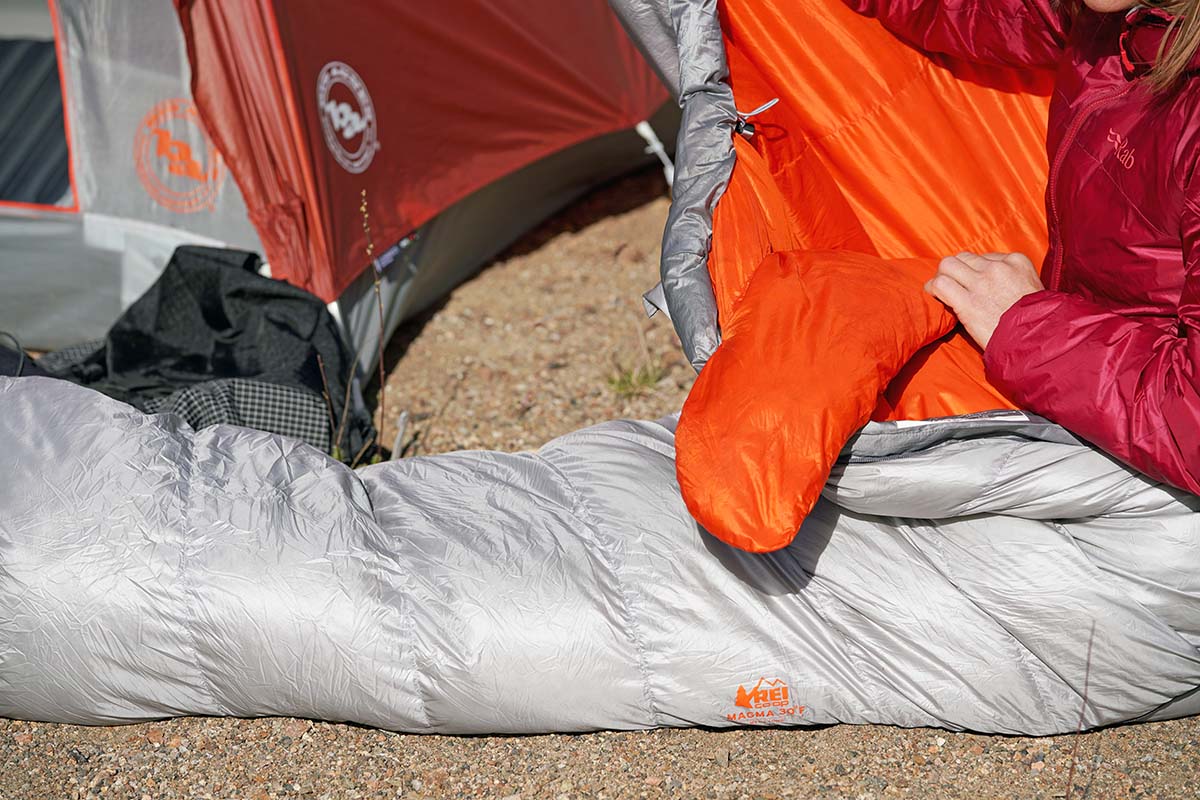
Baffle Design
The different stitching patterns on each individual sleeping bag and quilt may seem like they’re just for show, but this “baffling” actually is a critical design feature. Baffles essentially are tubes of fabric that help down insulation stay evenly distributed throughout a bag or quilt. Take one glance at the picks above and you’ll see a range of patterns, from the chevron baffles on the Loco Libre Operator Series Ghost Pepper Quilt (not listed above) to the horizontal tubes on the Feathered Friends Hummingbird and the vertical body baffles on the Zpacks Solo Quilt. Despite the range in appearances, these examples can be broken down into two main designs: continuous baffling and segmented baffling.
Continuous baffles, like those found on the Feathered Friends Hummingbird and Katabatic Gear Palisade, are tubes of feathers that go the entire width or length of a sleeping bag without being blocked by stitching or fabric. Feathers can move up and down these tubes as the user sees fit, depending on temperature swings. During cold evenings, move your features on top for added warmth; during warm evenings, shift them underneath you for a less insulated bag. The downside of continuous baffles is that feathers can occasionally move without you guiding them, leaving the sleeper shivering through the night.
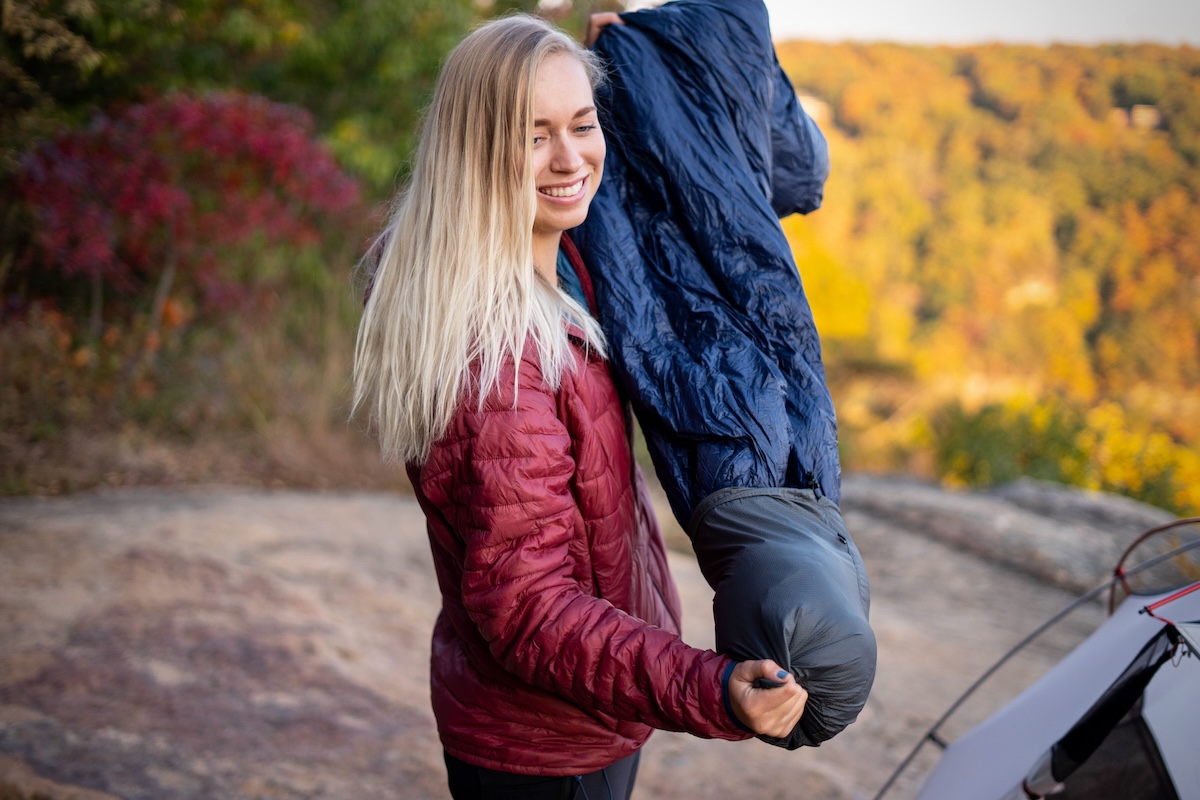
If you’re the type of person who loves tweaking your gear, continuous baffles could be a good fit. However, in most cases, we prefer bags and quilts with segmented baffles that keep feathers evenly distributed throughout. In the most premium bags, these compartments, or “boxed baffles,” are separated by lightweight material inside of the shell fabric rather than draft-prone stitching (and in the case of the Seamless Down Hugger, Montbell uses a web of lightweight yarn to keep the insulation in place). Most segmented baffles add a bit of weight, but for most, their convenience and warmth distribution are worth the tradeoff. We especially like the segmented baffle design of the popular Therm-a-Rest Hyperion (out of stock at the time of publishing), which strikes us as the best of both worlds. The Hyperion has 70% of its down strategically located on top of the bag and 30% on the underside—you get your insulation where it matters most, along with added assurance that it will stay put.
The origin of down insulation has become a hot topic, and we’re happy to see more companies jumping on board in support of responsibly sourced goose and duck plumage. Many brands now subscribe to the Responsible Down Standard (RDS), a global certification given to down products that indicates the birds were treated humanely and not subjected to unnecessary harm such as force-feeding or live-plucking. Further, some companies have developed their own standards, such as Patagonia’s Traceable Down Standard. All of the bags and quilts on our list above use ethically sourced down and are either certified by the RDS or backed by the manufacturer (Western Mountaineering, for example, works with a specific farm to source their down to ensure that responsible practices are being upheld).
_0.jpg)
If you plan to travel in humid or wet climates, we recommend looking for down insulation that has been treated to withstand light moisture. Water-repellent down, also known as hydrophobic down, is able to resist moisture much better than untreated down, dry out faster, and stay lofty even when wet. Although it’s certainly not as effective as synthetic insulation (see our article on down vs. synthetic insulation here), hydrophobic down adds a good dose of extra security (although there are very few instances when your bag or quilt should be exposed to moisture). In addition, look for shell fabrics that have been treated with a durable water repellant (DWR) finish, which adds an extra layer of caution for wet or snowy environments. Last but not least, a waterproof compression sack is a wise choice for the backcountry.
.jpg)
With an attempt to keep all of our ultralight sleeping bag options under 2 pounds, we have chosen to limit this list to 3-season sleeping bags, or bags rated to 20 degrees or higher. That said, ultralight winter sleeping bags do exist, which are ideal for temperatures you might find while adventuring in unpredictable shoulder seasons or while winter camping. One noteworthy choice is the Western Mountaineering Kodiak MF, a 0-degree bag that weighs an impressively light 2 pounds 15 ounces. Although this is quite a bit heavier than all of our ultralight options above, for a hardwearing, cold-weather sleeping bag, staying under 3 pounds is impressive. A second popular pick is the Feathered Friends Snowbunting ES 0, another 0-degree option at only 2 pounds 13 ounces. In addition to Western Mountaineering and Feathered Friends, most of the other brands above have winter-ready models available in their lineups. The designs are similar but they just have a lot more down fill.
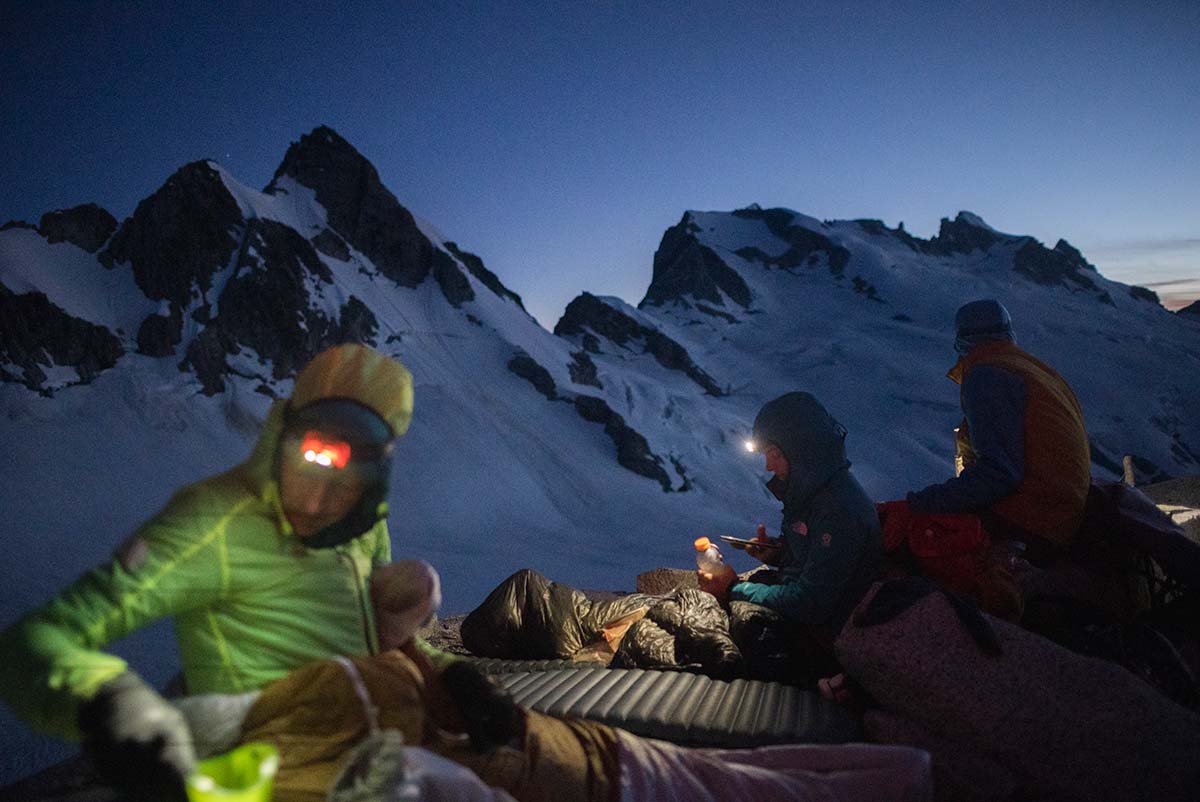
Unless you’re sleeping in a hammock, it’s incredibly important to pair your ultralight quilt or sleeping bag with an appropriately insulative sleeping pad. Even a plush, cold-weather sleeping bag will not keep you warm if you’re sleeping on the ground. This is most important when using ultralight quilts. Quilts rely on the insulation from your pad beneath you to keep you warm, as they are designed to simply drape over you, as opposed to zipping around you. Some quilts have the width to wrap around you fully and connect underneath you, but without a zipper drafts can more easily wiggle their way through. Most sleeping pads are given an R-value, which is a measurement of how well the pad can insulate you from the ground. For 3-season use, we recommend a pad with an R-value of at least 3 to 4, like the popular Therm-a-Rest NeoAir XLite NXT (R-value: 4.5).
.jpg)
If you’ve read through our list of quilts above, you might have noticed that many of the brands featured are not mainstream companies that sell through big retailers. The cottage industry is alive and well in ultralight gear manufacturing, and for good reason. Companies like Enlightened Equipment, Katabatic Gear, and Zpacks were all founded by outdoor—often thru-hiking—enthusiasts who noticed a gap in the market for ultralight equipment. These products are made by the people, for the people. In fact, it’s only in recent years that big brands like REI, Therm-a-Rest, and Marmot have thrown their hats into the ultralight ring.
These products often have a number of things in common. First, the designers and manufacturers generally are thru-hikers, bikepackers, and ultralight enthusiasts that use the gear they make. The result is well-thought-out products that nail the details and often allow the buyer to customize sizes, down fill, materials, and features. Further, since these are small companies, most of their gear is handmade in the United States. However, while we love this culture and encourage you to support it, keep in mind that you can expect longer wait times between ordering and receiving your items. And perhaps the biggest downside for most consumers: you won’t find brands like Zpacks and Enlightened Equipment on the shelves at your local retailer, meaning you won’t be able to see your bag/quilt or "try it on" before buying. Luckily, most of these companies include detailed videos and descriptions on their websites and have reasonable return policies.
Back to Our Top Ultralight Sleeping Bag Picks Back to Our Top Backpacking Quilt Picks